Deck 1: Certified Credit Research Analyst
Question
Question
Question
Question
Question
Question
Question
Question
Question
Question
Question
Question
Question
Question
Question
Question
Question
Question
Question
Question
Question
Question
Question
Question
Question
Question
Question
Question
Question
Question
Question
Question
Question
Question
Question
Question
Question
Question
Question
Question
Question
Question
Question
Question
Question
Question
Question
Question
Question
Question
Question
Question
Question
Question
Question
Question
Question
Question
Question
Question
Question
Question
Question
Question
Question
Question
Question
Question
Question
Question
Question
Question
Question
Question
Question
Question
Question
Question
Question
Question

Unlock Deck
Sign up to unlock the cards in this deck!
Unlock Deck
Unlock Deck
1/83
Play
Full screen (f)
Deck 1: Certified Credit Research Analyst
1
Ms. Mary Brown is a credit rating analyst. She had prepared a detailed report on one of her client, FlyHigh Airlines Ltd, a company operating chartered aircrafts in India. As she was heading for a meeting with her superior on the matter, coffee spilled over her set of prepared paper(s). As she was getting late for meeting, instead of preparing entire set she could recollect few numbers from her memory and reconstructed following partial financial table: 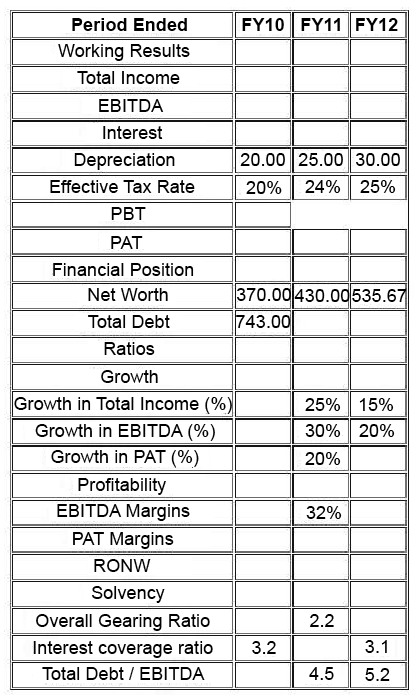 What is Total Income FY10 and FY12?
What is Total Income FY10 and FY12?
A) FY10: INR400 Million; FY12:INR575 Million
B) FY10: INR525.56 Million; FY12: INR755.49 Million
C) Insufficient Information to compute
D) FY10: INR656.94 Million; FY12: INR821.18 Million
 What is Total Income FY10 and FY12?
What is Total Income FY10 and FY12?A) FY10: INR400 Million; FY12:INR575 Million
B) FY10: INR525.56 Million; FY12: INR755.49 Million
C) Insufficient Information to compute
D) FY10: INR656.94 Million; FY12: INR821.18 Million
A
2
Following is information related banks: Auckland Ltd is a public sector bank operating with about 120 branches across India. The bank has been in business since 1971 and has about 40% branches in rural areas and about 75% of all branches are in Western India. On the basis of the size, Auckland Ltd will be ranked at number 31 amongst 40 banks in India. Although top management has appointment period of 5 years, generally they retire on ach sieving age of 60 years with an average tenure of only 2 years at the top job. Profit and Loss Account 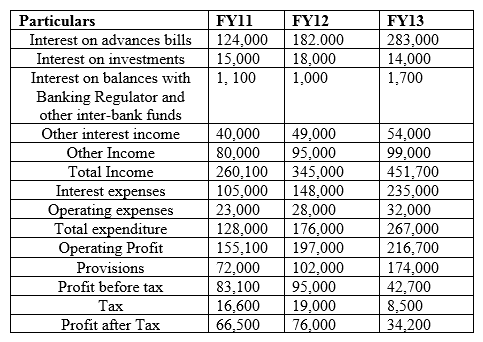 Balance Sheet
Balance Sheet 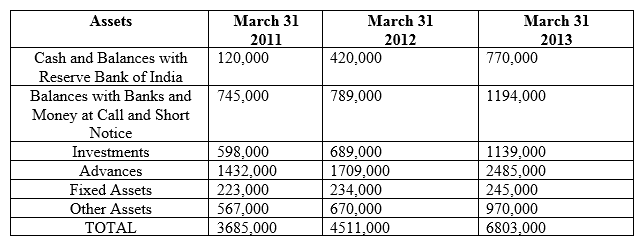
 The rating wise break-up of assets for FY11 is as follows:
The rating wise break-up of assets for FY11 is as follows: 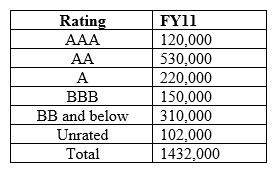 Computer risk weighted assets for Auckland Ltd for FY11:
Computer risk weighted assets for Auckland Ltd for FY11:
A) 10,10,000 Million
B) 13,24,500 Million
C) 11,64,500 Million
D) 11,60,000 Million
 Balance Sheet
Balance Sheet 
 The rating wise break-up of assets for FY11 is as follows:
The rating wise break-up of assets for FY11 is as follows:  Computer risk weighted assets for Auckland Ltd for FY11:
Computer risk weighted assets for Auckland Ltd for FY11:A) 10,10,000 Million
B) 13,24,500 Million
C) 11,64,500 Million
D) 11,60,000 Million
C
3
Satish Dhawan, a veteran fixed income trader is conducting interviews for the post of a junior fixed income trader. He interviewed four candidates Adam, Balkrishnan, Catherine and Deepak and following are the answers to his questions. Question 1: Tell something about Option Adjusted Spread Adam: OAS is applicable only to bond which do not have any options attached to it. It is for the plain bonds. Balkishna: In bonds with embedded options, AS reflects not only the credit risk but also reflects prepayment risk over and above the benchmark. Catherine: Sincespreads are calculated to know the level of credit risk in the bound, OAS is difference between in the Z spread and price of a call option for a callable bond. Deepark: For callable bond OAS will be lower than Z Spread. Question 2 : This is a spread that must be added to the benchmark zero rate curve in a parallel shift so that the sum of the risky bond's discounted cash flows equals its current market price. Which Spread I am talking about? Adam: Z Spread Balkrishna: Nominal Spread Catherine: Option Adjusted Spread Deepark: Asset Swap Spread Question 3 : What do you know about Interpolated spread and yield spread? Adam: Yield spread is the difference between the YTM of a risky bond and the YTM of an on-the-run treasury benchmark bond whose maturity is closest, but not identical to that of risky bond. Interpolated spread is the spread between the YTM of risky bond and the YTM of same maturity treasury benchmark, which is interpolated from the two nearest on-the-run treasury securities. Balkrishna: Interpolated spread is preferred to yield spread because the latter has the maturity mismatch, which leads to error if the yield curve is not flat and the benchmark security changes over time, leading to inconsistency. Catherine: Interpolated spread takes account the shape of the benchmark yield curve and therefore better than yield spread. Deepak: Both Interpolated Spread and Yield Spread rely on YTM which suffers from drawbacks and inconsistencies such as the assumption of flat yield curve and reinvestment at YTM itself. Then Satish gave following information related to the benchmark YTMs:  There is an 8.75% risky bond with a maturity of 2.75% year(s). Its current price is INR102.31, which corresponds to YTM of 8.52%. Compute Yield Spread from the information provided in the vignette:
There is an 8.75% risky bond with a maturity of 2.75% year(s). Its current price is INR102.31, which corresponds to YTM of 8.52%. Compute Yield Spread from the information provided in the vignette:
A) 0.13%
B) 0.00%
C) 0.36%
D) 0.27%
 There is an 8.75% risky bond with a maturity of 2.75% year(s). Its current price is INR102.31, which corresponds to YTM of 8.52%. Compute Yield Spread from the information provided in the vignette:
There is an 8.75% risky bond with a maturity of 2.75% year(s). Its current price is INR102.31, which corresponds to YTM of 8.52%. Compute Yield Spread from the information provided in the vignette:A) 0.13%
B) 0.00%
C) 0.36%
D) 0.27%
C
4
"Following four entities operate in the Indian IT and BPO space. They all are into same segment of providing off-shore analytical services. They all operate on the labour cost-arbitrage in India and the countries of their clients. Following information pertains for the year ended March 31, 201 3. 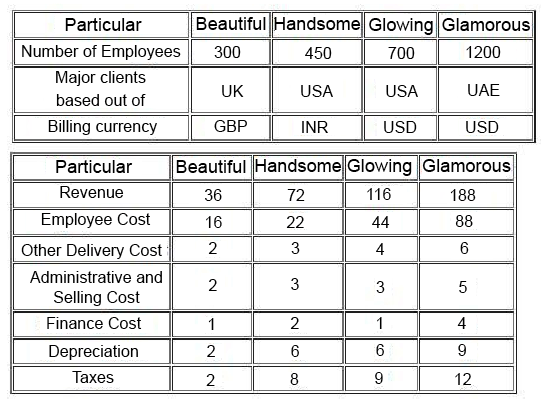
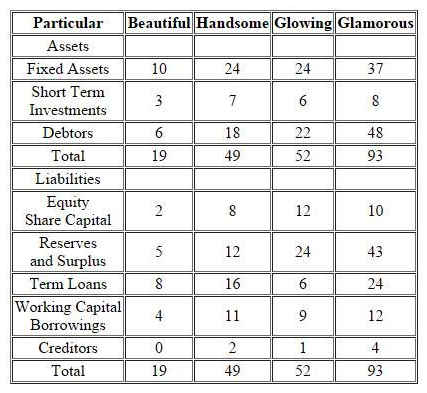 The year FY13, was typically a good year for Indian IT companies. For FY14, the economic analysts have given following predictions about the IT Industry: A) It is expected that INR will appreciate sharply against other USD. B) Given high inflation and attrition in IT Industry in India, the wages of IT sector employees will increase more sharply than Inflation and general wage rise in country. C) US Congress will be passing a bill which restricts the outsourcing to third world countries like India. While analyzing the four entities, you come across following findings related to Glowing: Glowing is promoted by Mr.M R Bhutta, who has earlier promoted two other business ventures, He started with ABC Entertainment Ltd in 1996 and was promoter and MD of the company. ABC was a listed entity and its share price had sharp movements at the time of stock market scam in late 1990s. In 1999, Mr. Bhutta sold his entire stake and resigned from the post of MD. The stock price declined by about 90% in coming days and has never recovered. Later on in 2003, Mr. Bhutta again promoted a new business, Klear Publications Ltd (KCL) an in the business of magazine publication. The entity had come out with a successful IPO and raised money from public. Thereafter it ran into troubles and reported losses. In 2009, Mr. Bhutta went on to exit this business as well by selling stake to other promoter(s). There have been reports in both instances with allegations that promoters have siphoned off money from listed entities to other group entities, however, nothing has been proved in any court." Based on your findings in the case of Glowing, how will you handle the same as a credit rating analyst:
The year FY13, was typically a good year for Indian IT companies. For FY14, the economic analysts have given following predictions about the IT Industry: A) It is expected that INR will appreciate sharply against other USD. B) Given high inflation and attrition in IT Industry in India, the wages of IT sector employees will increase more sharply than Inflation and general wage rise in country. C) US Congress will be passing a bill which restricts the outsourcing to third world countries like India. While analyzing the four entities, you come across following findings related to Glowing: Glowing is promoted by Mr.M R Bhutta, who has earlier promoted two other business ventures, He started with ABC Entertainment Ltd in 1996 and was promoter and MD of the company. ABC was a listed entity and its share price had sharp movements at the time of stock market scam in late 1990s. In 1999, Mr. Bhutta sold his entire stake and resigned from the post of MD. The stock price declined by about 90% in coming days and has never recovered. Later on in 2003, Mr. Bhutta again promoted a new business, Klear Publications Ltd (KCL) an in the business of magazine publication. The entity had come out with a successful IPO and raised money from public. Thereafter it ran into troubles and reported losses. In 2009, Mr. Bhutta went on to exit this business as well by selling stake to other promoter(s). There have been reports in both instances with allegations that promoters have siphoned off money from listed entities to other group entities, however, nothing has been proved in any court." Based on your findings in the case of Glowing, how will you handle the same as a credit rating analyst:
A) Be more cautious and skeptical on any information received from Glowing and give negative marks in management risk and use it as an overriding factor to lower the credit ratings.
B) Any of the three.
C) Deny taking up assignment for Glowing.
D) One needs to check only the corporate governance aspect of the Glowing and the past same should not have any bearing on Glowing.

 The year FY13, was typically a good year for Indian IT companies. For FY14, the economic analysts have given following predictions about the IT Industry: A) It is expected that INR will appreciate sharply against other USD. B) Given high inflation and attrition in IT Industry in India, the wages of IT sector employees will increase more sharply than Inflation and general wage rise in country. C) US Congress will be passing a bill which restricts the outsourcing to third world countries like India. While analyzing the four entities, you come across following findings related to Glowing: Glowing is promoted by Mr.M R Bhutta, who has earlier promoted two other business ventures, He started with ABC Entertainment Ltd in 1996 and was promoter and MD of the company. ABC was a listed entity and its share price had sharp movements at the time of stock market scam in late 1990s. In 1999, Mr. Bhutta sold his entire stake and resigned from the post of MD. The stock price declined by about 90% in coming days and has never recovered. Later on in 2003, Mr. Bhutta again promoted a new business, Klear Publications Ltd (KCL) an in the business of magazine publication. The entity had come out with a successful IPO and raised money from public. Thereafter it ran into troubles and reported losses. In 2009, Mr. Bhutta went on to exit this business as well by selling stake to other promoter(s). There have been reports in both instances with allegations that promoters have siphoned off money from listed entities to other group entities, however, nothing has been proved in any court." Based on your findings in the case of Glowing, how will you handle the same as a credit rating analyst:
The year FY13, was typically a good year for Indian IT companies. For FY14, the economic analysts have given following predictions about the IT Industry: A) It is expected that INR will appreciate sharply against other USD. B) Given high inflation and attrition in IT Industry in India, the wages of IT sector employees will increase more sharply than Inflation and general wage rise in country. C) US Congress will be passing a bill which restricts the outsourcing to third world countries like India. While analyzing the four entities, you come across following findings related to Glowing: Glowing is promoted by Mr.M R Bhutta, who has earlier promoted two other business ventures, He started with ABC Entertainment Ltd in 1996 and was promoter and MD of the company. ABC was a listed entity and its share price had sharp movements at the time of stock market scam in late 1990s. In 1999, Mr. Bhutta sold his entire stake and resigned from the post of MD. The stock price declined by about 90% in coming days and has never recovered. Later on in 2003, Mr. Bhutta again promoted a new business, Klear Publications Ltd (KCL) an in the business of magazine publication. The entity had come out with a successful IPO and raised money from public. Thereafter it ran into troubles and reported losses. In 2009, Mr. Bhutta went on to exit this business as well by selling stake to other promoter(s). There have been reports in both instances with allegations that promoters have siphoned off money from listed entities to other group entities, however, nothing has been proved in any court." Based on your findings in the case of Glowing, how will you handle the same as a credit rating analyst:A) Be more cautious and skeptical on any information received from Glowing and give negative marks in management risk and use it as an overriding factor to lower the credit ratings.
B) Any of the three.
C) Deny taking up assignment for Glowing.
D) One needs to check only the corporate governance aspect of the Glowing and the past same should not have any bearing on Glowing.

Unlock Deck
Unlock for access to all 83 flashcards in this deck.
Unlock Deck
k this deck
5
Scott is a credit analyst with one of the credit rating agencies in India. He was looking in Oil and Gas Industry companies and has presented brief financials for following 4 entities:  From the data given below, calculate the standard deviation of the credit portfolio assuming that facility's exposure is known with certainty, customer defaults and LGDs are independent of one another and LGDs are independent across borrower(s). Credit Facility A - Loss Equivalent Exposure of $60m, expected Default frequency of 1.5%, loss given default of 30%, Std Deviation of LGD - 5% and Correlation to portfolio - 0.10 Credit Facility B - Loss Equivalent Exposure of $25m, expected Default frequency of 2%, loss given default of 12%, Std Deviation of LGD - 12% and Correlation to portfolio - 0.45 Credit Facility C - Loss Equivalent Exposure of $15m, expected Default frequency of 5%, loss given default of 85%, Std Deviation of LGD - 18% and Correlation to portfolio - 0.22
From the data given below, calculate the standard deviation of the credit portfolio assuming that facility's exposure is known with certainty, customer defaults and LGDs are independent of one another and LGDs are independent across borrower(s). Credit Facility A - Loss Equivalent Exposure of $60m, expected Default frequency of 1.5%, loss given default of 30%, Std Deviation of LGD - 5% and Correlation to portfolio - 0.10 Credit Facility B - Loss Equivalent Exposure of $25m, expected Default frequency of 2%, loss given default of 12%, Std Deviation of LGD - 12% and Correlation to portfolio - 0.45 Credit Facility C - Loss Equivalent Exposure of $15m, expected Default frequency of 5%, loss given default of 85%, Std Deviation of LGD - 18% and Correlation to portfolio - 0.22
A) US$6.88 million
B) US$ 1.16 million
C) US$ 1.66 million
D) US$ 0.10 million
 From the data given below, calculate the standard deviation of the credit portfolio assuming that facility's exposure is known with certainty, customer defaults and LGDs are independent of one another and LGDs are independent across borrower(s). Credit Facility A - Loss Equivalent Exposure of $60m, expected Default frequency of 1.5%, loss given default of 30%, Std Deviation of LGD - 5% and Correlation to portfolio - 0.10 Credit Facility B - Loss Equivalent Exposure of $25m, expected Default frequency of 2%, loss given default of 12%, Std Deviation of LGD - 12% and Correlation to portfolio - 0.45 Credit Facility C - Loss Equivalent Exposure of $15m, expected Default frequency of 5%, loss given default of 85%, Std Deviation of LGD - 18% and Correlation to portfolio - 0.22
From the data given below, calculate the standard deviation of the credit portfolio assuming that facility's exposure is known with certainty, customer defaults and LGDs are independent of one another and LGDs are independent across borrower(s). Credit Facility A - Loss Equivalent Exposure of $60m, expected Default frequency of 1.5%, loss given default of 30%, Std Deviation of LGD - 5% and Correlation to portfolio - 0.10 Credit Facility B - Loss Equivalent Exposure of $25m, expected Default frequency of 2%, loss given default of 12%, Std Deviation of LGD - 12% and Correlation to portfolio - 0.45 Credit Facility C - Loss Equivalent Exposure of $15m, expected Default frequency of 5%, loss given default of 85%, Std Deviation of LGD - 18% and Correlation to portfolio - 0.22A) US$6.88 million
B) US$ 1.16 million
C) US$ 1.66 million
D) US$ 0.10 million

Unlock Deck
Unlock for access to all 83 flashcards in this deck.
Unlock Deck
k this deck
6
The longer the term to maturity of bond:
A) term to maturity and price of a bond are not related
B) The lesser is the risk associated with price of a bond
C) The higher is the return from the bond
D) The more risk in the price of a bond
A) term to maturity and price of a bond are not related
B) The lesser is the risk associated with price of a bond
C) The higher is the return from the bond
D) The more risk in the price of a bond

Unlock Deck
Unlock for access to all 83 flashcards in this deck.
Unlock Deck
k this deck
7
Scott is a credit analyst with one of the credit rating agencies in India. He was looking in Oil and Gas Industry companies and has presented brief financials for following 4 entities:  Two credit analysts are discussing the DM-approach to credit risk modeling. They make the following statements: Analyst A: A portfolio's standard deviation of credit losses can be determined by considering the standard deviation of credit losses of individual exposures in the portfolio and summing them all up. Analyst B: I do not fully agree with that. Apart from individual standard deviations, one also needs to consider the correlation of the exposure with the rest of the portfolio so as to account for diversification effects. Higher correlations among credit exposures will lead to higher standard deviation of the overall portfolio.
Two credit analysts are discussing the DM-approach to credit risk modeling. They make the following statements: Analyst A: A portfolio's standard deviation of credit losses can be determined by considering the standard deviation of credit losses of individual exposures in the portfolio and summing them all up. Analyst B: I do not fully agree with that. Apart from individual standard deviations, one also needs to consider the correlation of the exposure with the rest of the portfolio so as to account for diversification effects. Higher correlations among credit exposures will lead to higher standard deviation of the overall portfolio.
A) Only Analyst A is correct
B) Both are correct
C) Only Analyst B is correct
D) Both are incorrect
 Two credit analysts are discussing the DM-approach to credit risk modeling. They make the following statements: Analyst A: A portfolio's standard deviation of credit losses can be determined by considering the standard deviation of credit losses of individual exposures in the portfolio and summing them all up. Analyst B: I do not fully agree with that. Apart from individual standard deviations, one also needs to consider the correlation of the exposure with the rest of the portfolio so as to account for diversification effects. Higher correlations among credit exposures will lead to higher standard deviation of the overall portfolio.
Two credit analysts are discussing the DM-approach to credit risk modeling. They make the following statements: Analyst A: A portfolio's standard deviation of credit losses can be determined by considering the standard deviation of credit losses of individual exposures in the portfolio and summing them all up. Analyst B: I do not fully agree with that. Apart from individual standard deviations, one also needs to consider the correlation of the exposure with the rest of the portfolio so as to account for diversification effects. Higher correlations among credit exposures will lead to higher standard deviation of the overall portfolio.A) Only Analyst A is correct
B) Both are correct
C) Only Analyst B is correct
D) Both are incorrect

Unlock Deck
Unlock for access to all 83 flashcards in this deck.
Unlock Deck
k this deck
8
Mr. Gopi, while teaching the CCRA course to students described Altman's Model and stated that following variables do exist for Altman's Model:
1) total debt/total assets,
2) retained earnings/total assets.
3)earnings before interest and taxes/total assets,
4)market value equity/book value of total liabilities,
5)sales/total assets Exactly how many variables are incorrectly identified?
A) Exactly Four
B) Exactly One
C) Exactly Two
D) Exactly Three
1) total debt/total assets,
2) retained earnings/total assets.
3)earnings before interest and taxes/total assets,
4)market value equity/book value of total liabilities,
5)sales/total assets Exactly how many variables are incorrectly identified?
A) Exactly Four
B) Exactly One
C) Exactly Two
D) Exactly Three

Unlock Deck
Unlock for access to all 83 flashcards in this deck.
Unlock Deck
k this deck
9
The following information pertains to bonds: 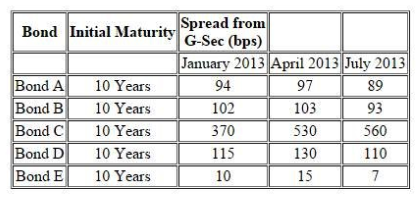 Further following information is available about a particular bond 'Bond F' There is a 10.25% risky bond with a maturity of 2.25% year(s) its current price is INR105.31, which corresponds to YTM of 9.22%. The following are the benchmark YTMs.
Further following information is available about a particular bond 'Bond F' There is a 10.25% risky bond with a maturity of 2.25% year(s) its current price is INR105.31, which corresponds to YTM of 9.22%. The following are the benchmark YTMs.  Assume that the general market rates have increased. An issuer, Revolution Ltd has plans to roll over its existing commercial paper and forth coming reset dates for its floating rate bonds are very near. Which of the following ratios for revolution will get impacted?
Assume that the general market rates have increased. An issuer, Revolution Ltd has plans to roll over its existing commercial paper and forth coming reset dates for its floating rate bonds are very near. Which of the following ratios for revolution will get impacted?
A) Interest Coverage and Return on assets
B) DSCR, and Return on Assets
C) DSCR, Interest Coverage and Return on assets
D) DSCR and interest Coverage
 Further following information is available about a particular bond 'Bond F' There is a 10.25% risky bond with a maturity of 2.25% year(s) its current price is INR105.31, which corresponds to YTM of 9.22%. The following are the benchmark YTMs.
Further following information is available about a particular bond 'Bond F' There is a 10.25% risky bond with a maturity of 2.25% year(s) its current price is INR105.31, which corresponds to YTM of 9.22%. The following are the benchmark YTMs.  Assume that the general market rates have increased. An issuer, Revolution Ltd has plans to roll over its existing commercial paper and forth coming reset dates for its floating rate bonds are very near. Which of the following ratios for revolution will get impacted?
Assume that the general market rates have increased. An issuer, Revolution Ltd has plans to roll over its existing commercial paper and forth coming reset dates for its floating rate bonds are very near. Which of the following ratios for revolution will get impacted?A) Interest Coverage and Return on assets
B) DSCR, and Return on Assets
C) DSCR, Interest Coverage and Return on assets
D) DSCR and interest Coverage

Unlock Deck
Unlock for access to all 83 flashcards in this deck.
Unlock Deck
k this deck
10
The following information pertains to bonds: 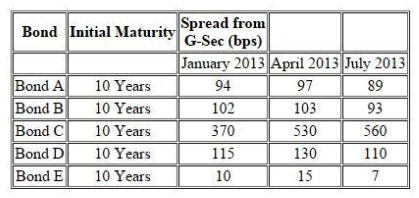 Further following information is available about a particular bond 'Bond F' There is a 10.25% risky bond with a maturity of 2.25% year(s) its current price is INR105.31, which corresponds to YTM of 9.22%. The following are the benchmark YTMs.
Further following information is available about a particular bond 'Bond F' There is a 10.25% risky bond with a maturity of 2.25% year(s) its current price is INR105.31, which corresponds to YTM of 9.22%. The following are the benchmark YTMs.  Assuming the G-Sec has not changed from the time January 2013 to April 2013, what can you predict about the changes bond price and change in issues borrowing rates:
Assuming the G-Sec has not changed from the time January 2013 to April 2013, what can you predict about the changes bond price and change in issues borrowing rates:
A) Decrease and Increase
B) Increase and Increase
C) Decrease and Decrease
D) Increase and Decrease
 Further following information is available about a particular bond 'Bond F' There is a 10.25% risky bond with a maturity of 2.25% year(s) its current price is INR105.31, which corresponds to YTM of 9.22%. The following are the benchmark YTMs.
Further following information is available about a particular bond 'Bond F' There is a 10.25% risky bond with a maturity of 2.25% year(s) its current price is INR105.31, which corresponds to YTM of 9.22%. The following are the benchmark YTMs.  Assuming the G-Sec has not changed from the time January 2013 to April 2013, what can you predict about the changes bond price and change in issues borrowing rates:
Assuming the G-Sec has not changed from the time January 2013 to April 2013, what can you predict about the changes bond price and change in issues borrowing rates:A) Decrease and Increase
B) Increase and Increase
C) Decrease and Decrease
D) Increase and Decrease

Unlock Deck
Unlock for access to all 83 flashcards in this deck.
Unlock Deck
k this deck
11
Following is information related banks: Auckland Ltd is a public sector bank operating with about 120 branches across India. The bank has been in business since 1971 and has about 40% branches in rural areas and about 75% of all branches are in Western India. On the basis of the size, Auckland Ltd will be ranked at number 31 amongst 40 banks in India. Although top management has appointment period of 5 years, generally they retire on ach sieving age of 60 years with an average tenure of only 2 years at the top job. Profit and Loss Account 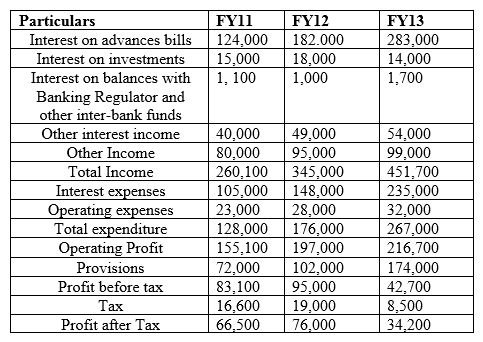 Balance Sheet
Balance Sheet 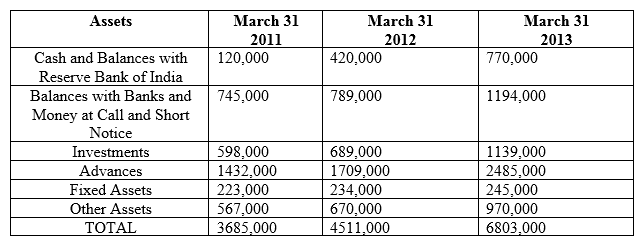
 The rating wise break-up of assets for FY11 is as follows:
The rating wise break-up of assets for FY11 is as follows: 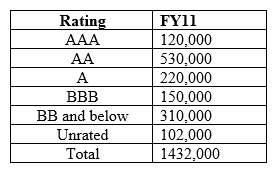 During which year amongst the three, was the overall financial profile of bank most string?
During which year amongst the three, was the overall financial profile of bank most string?
A) No change in three years
B) FY13
C) FY11
D) FY12
 Balance Sheet
Balance Sheet 
 The rating wise break-up of assets for FY11 is as follows:
The rating wise break-up of assets for FY11 is as follows:  During which year amongst the three, was the overall financial profile of bank most string?
During which year amongst the three, was the overall financial profile of bank most string?A) No change in three years
B) FY13
C) FY11
D) FY12

Unlock Deck
Unlock for access to all 83 flashcards in this deck.
Unlock Deck
k this deck
12
Satish Dhawan, a veteran fixed income trader is conducting interviews for the post of a junior fixed income trader. He interviewed four candidates Adam, Balkrishnan, Catherine and Deepak and following are the answers to his questions. Question 1: Tell something about Option Adjusted Spread Adam: OAS is applicable only to bond which do not have any options attached to it. It is for the plain bonds. Balkishna: In bonds with embedded options, AS reflects not only the credit risk but also reflects prepayment risk over and above the benchmark. Catherine: Sincespreads are calculated to know the level of credit risk in the bound, OAS is difference between in the Z spread and price of a call option for a callable bond. Deepark: For callable bond OAS will be lower than Z Spread. Question 2 : This is a spread that must be added to the benchmark zero rate curve in a parallel shift so that the sum of the risky bond's discounted cash flows equals its current market price. Which Spread I am talking about? Adam: Z Spread Balkrishna: Nominal Spread Catherine: Option Adjusted Spread Deepark: Asset Swap Spread Question 3 : What do you know about Interpolated spread and yield spread? Adam: Yield spread is the difference between the YTM of a risky bond and the YTM of an on-the-run treasury benchmark bond whose maturity is closest, but not identical to that of risky bond. Interpolated spread is the spread between the YTM of risky bond and the YTM of same maturity treasury benchmark, which is interpolated from the two nearest on-the-run treasury securities. Balkrishna: Interpolated spread is preferred to yield spread because the latter has the maturity mismatch, which leads to error if the yield curve is not flat and the benchmark security changes over time, leading to inconsistency. Catherine: Interpolated spread takes account the shape of the benchmark yield curve and therefore better than yield spread. Deepak: Both Interpolated Spread and Yield Spread rely on YTM which suffers from drawbacks and inconsistencies such as the assumption of flat yield curve and reinvestment at YTM itself. Then Satish gave following information related to the benchmark YTMs:  Who amongst the four candidates is correct regarding OAS?
Who amongst the four candidates is correct regarding OAS?
A) Only Catherine
B) Only Deepak
C) Only Adam and Catherine
D) Only Deepak and Catherine
 Who amongst the four candidates is correct regarding OAS?
Who amongst the four candidates is correct regarding OAS?A) Only Catherine
B) Only Deepak
C) Only Adam and Catherine
D) Only Deepak and Catherine

Unlock Deck
Unlock for access to all 83 flashcards in this deck.
Unlock Deck
k this deck
13
If XYZ Ltd. incurs (with purchase and installation of machinery) using cash, which of the following ratios will remain unchanged, if all other things remain constant?
A) None of the three
B) Asset Turnover ratio
C) Current Ratio
D) Quick Ratio
A) None of the three
B) Asset Turnover ratio
C) Current Ratio
D) Quick Ratio

Unlock Deck
Unlock for access to all 83 flashcards in this deck.
Unlock Deck
k this deck
14
Loss assets should be written off. If loss assets are permitted to remain in the books for any reason, ______percent of the outstanding should be provided for.
A) 150
B) 75
C) 100
D) 50
A) 150
B) 75
C) 100
D) 50

Unlock Deck
Unlock for access to all 83 flashcards in this deck.
Unlock Deck
k this deck
15
Two economies HardLand and SincereLand have provided following information with respect to their economies in USD Billion: 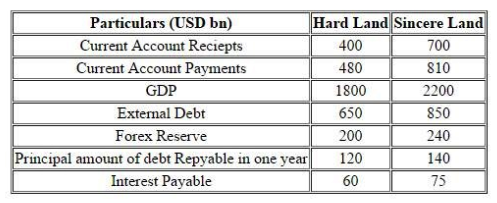 Based on the above information which entity is better in terms of current account deficit %?
Based on the above information which entity is better in terms of current account deficit %?
A) Sincereland by 583 bps
B) Hardland by 56 bps
C) Sincereland by 56 bps
D) Hardland by 583 bps
 Based on the above information which entity is better in terms of current account deficit %?
Based on the above information which entity is better in terms of current account deficit %?A) Sincereland by 583 bps
B) Hardland by 56 bps
C) Sincereland by 56 bps
D) Hardland by 583 bps

Unlock Deck
Unlock for access to all 83 flashcards in this deck.
Unlock Deck
k this deck
16
Ms. Mary Brown is a credit rating analyst. She had prepared a detailed report on one of her client, FlyHigh Airlines Ltd, a company operating chartered aircrafts in India. As she was heading for a meeting with her superior on the matter, coffee spilled over her set of prepared paper(s). As she was getting late for meeting, instead of preparing entire set she could recollect few numbers from her memory and reconstructed following partial financial table: 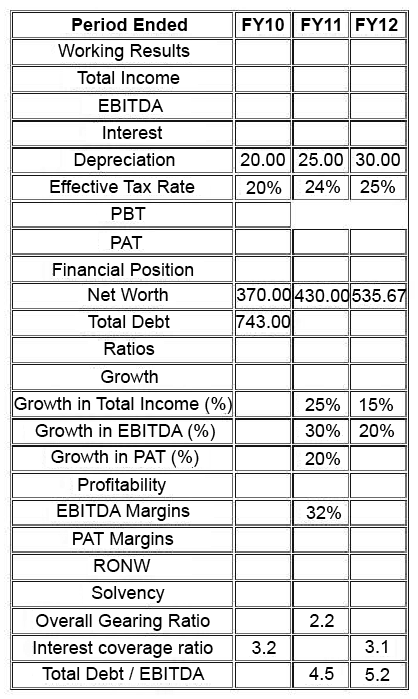 PAT margins are highest in which of the years?
PAT margins are highest in which of the years?
A) FY12
B) FY11
C) FY10
D) Equal in FY10 and FY12
 PAT margins are highest in which of the years?
PAT margins are highest in which of the years?A) FY12
B) FY11
C) FY10
D) Equal in FY10 and FY12

Unlock Deck
Unlock for access to all 83 flashcards in this deck.
Unlock Deck
k this deck
17
Scott is a credit analyst with one of the credit rating agencies in India. He was looking in Oil and Gas Industry companies and has presented brief financials for following 4 entities:  Which of the four entities has best interest coverage ratios?
Which of the four entities has best interest coverage ratios?
A) C Ltd
B) D Ltd
C) A Ltd
D) B Ltd
 Which of the four entities has best interest coverage ratios?
Which of the four entities has best interest coverage ratios?A) C Ltd
B) D Ltd
C) A Ltd
D) B Ltd

Unlock Deck
Unlock for access to all 83 flashcards in this deck.
Unlock Deck
k this deck
18
Ms. Mary Brown is a credit rating analyst. She had prepared a detailed report on one of her client, FlyHigh Airlines Ltd, a company operating chartered aircrafts in India. As she was heading for a meeting with her superior on the matter, coffee spilled over her set of prepared paper(s). As she was getting late for meeting, instead of preparing entire set she could recollect few numbers from her memory and reconstructed following partial financial table: 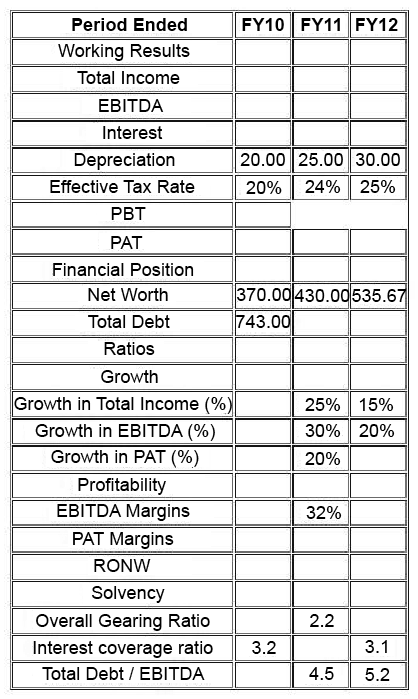 An analyst comparing two competitors Comp Systems and Big Tables gathers the data below: Cash Conversions Cycle: Comp Systems: 18 days and Big Tables 32 days Defense Interval Ratio: Comp Systems: 50 and Big Tables: 20 What can the analyst conclude regarding the liquidity of these companies?
An analyst comparing two competitors Comp Systems and Big Tables gathers the data below: Cash Conversions Cycle: Comp Systems: 18 days and Big Tables 32 days Defense Interval Ratio: Comp Systems: 50 and Big Tables: 20 What can the analyst conclude regarding the liquidity of these companies?
A) Both indicators suggest that Comp Systems is more liquid than Big Tables
B) Both indicators suggest that Big Tables manages it/s cash better than Comp Systems
C) Both indicators give contradictory results
D) While Comp Systems is more liquid as per the Cash conversion cycle, Big Tables manages its cash better as indicated by a lower, hence better Defense Ratio
 An analyst comparing two competitors Comp Systems and Big Tables gathers the data below: Cash Conversions Cycle: Comp Systems: 18 days and Big Tables 32 days Defense Interval Ratio: Comp Systems: 50 and Big Tables: 20 What can the analyst conclude regarding the liquidity of these companies?
An analyst comparing two competitors Comp Systems and Big Tables gathers the data below: Cash Conversions Cycle: Comp Systems: 18 days and Big Tables 32 days Defense Interval Ratio: Comp Systems: 50 and Big Tables: 20 What can the analyst conclude regarding the liquidity of these companies?A) Both indicators suggest that Comp Systems is more liquid than Big Tables
B) Both indicators suggest that Big Tables manages it/s cash better than Comp Systems
C) Both indicators give contradictory results
D) While Comp Systems is more liquid as per the Cash conversion cycle, Big Tables manages its cash better as indicated by a lower, hence better Defense Ratio

Unlock Deck
Unlock for access to all 83 flashcards in this deck.
Unlock Deck
k this deck
19
Case Facts as on March 31, 2012 Mark Construction Company (MCC) has bagged a contract for construction of a large dam and hydro power project on river Shivna in Madhya Pradesh (MP). The project is also of relevance from the irrigation perspective due to its location and as per the agreement MCC will have to undertake construction of web of canals, approach road to dam, power house and other ancillary units. MCC is promoted by Mr. Thomas Mark, who is a MP from the ruling party which recently formed government in MP. Historically, MCC has been engaged into construction of rural roads, small bridges and railway platforms on contract basis for the Government. MCC will have a separate special purpose vehicle (SPV) floated for this venture. The hydro power project comes under the public private partnership scheme of the Government of MP, where in the private partner builds owns operates and transfers (BOOT) the hydro power plant. The detailed terms of the hydro power project agreement are as follows:
1) The construction of the dam, canals and hydro power plant shall be undertaken by the contractor. The Government of MP will have to acquire land which will submerge on construction of dam and shall rehabilitate the owners of land.
2) MCC shall have right to operate the hydro power project from date of commencement of commercial operations (DCCO) for a period of 20 years and shall transfer the project to Government thereafter. Further, SPV shall be tax exempt for a period of five years from DCCO i.e. FY17-FY21.
3)The power project is of 600 megawatts (MW) shall comprise 4 units of 150 MW each. The estimated cost of project is about INR3, 500 Million to be spent over a period of 4 year(s) the project is estimated to be commercially operational by April 1, 2016 with two units operational om same day and one unit each will be operational on April 1, 2017 and April 1, 2018.
4)Means of finance: Means of Finance INR Million Government Aid (To be classified as Equity) 500Equity 900 Debt 2100
Means of Finance INR Million Government Aid (To be classified as Equity) 500Equity 900 Debt 2100
5)Amount if expenditure estimated in various years is as follows: Debt shall bear a fixed rate of interest of 10% and all interest till DCCO shall be added to the principal. The expected principal along with capitalized interest is expected to be INR2, 400 Million (i.e.INR2100 Million debt plus INR300 Million capitalized interest). The repayment of the same shall be in 12 equated annual installments starting from FY17. Brief projections for the period of FY17 to FY21 are given below: Developments as on March 31, 2015 The project manager for the SPV made following comments at a press conferee on March 31, 2015: As you all are aware, we were running bang on schedule till we last met on December 21, 2014.From today we are just left with one more year to complete the project in time. However, the flash floods which struck our dam site on this March 15, 2015 have created havoc in the region. I shall not point out the loss of lives in the region as you all are well aware of those. Our project has also been badly hit due to the same and we have been assessing the damage over the last one week. After analyzing damage, we have made changes in project schedule. Now we will be making only one unit of 150 MW operational on April 1, 2016 and 1 unit each will be added in each of subsequent year(s). Development as on September 30, 2015 Post the flash floods, lot of environmentalists started raising issues of changes in environment due to construction of large number of dams. A few Public Interest Litigations (PILs) have been filed in various courts. Honorable High Court of MP on September 27, 2015, banned construction of any dams in the region and banned permissions for new dams till next hearing scheduled on November 30, 201
Developments as on March 31, 2015 The project manager for the SPV made following comments at a press conferee on March 31, 2015: As you all are aware, we were running bang on schedule till we last met on December 21, 2014.From today we are just left with one more year to complete the project in time. However, the flash floods which struck our dam site on this March 15, 2015 have created havoc in the region. I shall not point out the loss of lives in the region as you all are well aware of those. Our project has also been badly hit due to the same and we have been assessing the damage over the last one week. After analyzing damage, we have made changes in project schedule. Now we will be making only one unit of 150 MW operational on April 1, 2016 and 1 unit each will be added in each of subsequent year(s). Development as on September 30, 2015 Post the flash floods, lot of environmentalists started raising issues of changes in environment due to construction of large number of dams. A few Public Interest Litigations (PILs) have been filed in various courts. Honorable High Court of MP on September 27, 2015, banned construction of any dams in the region and banned permissions for new dams till next hearing scheduled on November 30, 201
5)MCC in its press release has indicated that they will apply to the higher court on the matter. On receiving the credit proposal, the banker informed the company that in FY17 the DSCR is below unity, which is not acceptable to bank. Which of the following is correct?
A) Had the cash accruals be more by INR50 Million, DSCR would have been unity. SPV can provide an implicit credit enhancement for the same from MCC.
B) Had the cash accruals be more by INR8 Million, DSCR would have been unity. SPV can provide an implicit credit enhancement for the same from MCC.
C) Had the cash accruals be more by INR8 Million, DSCR would have been unity, SPV can provide an explicit credit enhancement for the same from MCC.
D) Had the cash accruals be more by INR12 Million, DSCR would have been unity. SPV can provide an explicit credit enhancement for the same from MCC.
1) The construction of the dam, canals and hydro power plant shall be undertaken by the contractor. The Government of MP will have to acquire land which will submerge on construction of dam and shall rehabilitate the owners of land.
2) MCC shall have right to operate the hydro power project from date of commencement of commercial operations (DCCO) for a period of 20 years and shall transfer the project to Government thereafter. Further, SPV shall be tax exempt for a period of five years from DCCO i.e. FY17-FY21.
3)The power project is of 600 megawatts (MW) shall comprise 4 units of 150 MW each. The estimated cost of project is about INR3, 500 Million to be spent over a period of 4 year(s) the project is estimated to be commercially operational by April 1, 2016 with two units operational om same day and one unit each will be operational on April 1, 2017 and April 1, 2018.
4)Means of finance:
 Means of Finance INR Million Government Aid (To be classified as Equity) 500Equity 900 Debt 2100
Means of Finance INR Million Government Aid (To be classified as Equity) 500Equity 900 Debt 21005)Amount if expenditure estimated in various years is as follows: Debt shall bear a fixed rate of interest of 10% and all interest till DCCO shall be added to the principal. The expected principal along with capitalized interest is expected to be INR2, 400 Million (i.e.INR2100 Million debt plus INR300 Million capitalized interest). The repayment of the same shall be in 12 equated annual installments starting from FY17. Brief projections for the period of FY17 to FY21 are given below:
 Developments as on March 31, 2015 The project manager for the SPV made following comments at a press conferee on March 31, 2015: As you all are aware, we were running bang on schedule till we last met on December 21, 2014.From today we are just left with one more year to complete the project in time. However, the flash floods which struck our dam site on this March 15, 2015 have created havoc in the region. I shall not point out the loss of lives in the region as you all are well aware of those. Our project has also been badly hit due to the same and we have been assessing the damage over the last one week. After analyzing damage, we have made changes in project schedule. Now we will be making only one unit of 150 MW operational on April 1, 2016 and 1 unit each will be added in each of subsequent year(s). Development as on September 30, 2015 Post the flash floods, lot of environmentalists started raising issues of changes in environment due to construction of large number of dams. A few Public Interest Litigations (PILs) have been filed in various courts. Honorable High Court of MP on September 27, 2015, banned construction of any dams in the region and banned permissions for new dams till next hearing scheduled on November 30, 201
Developments as on March 31, 2015 The project manager for the SPV made following comments at a press conferee on March 31, 2015: As you all are aware, we were running bang on schedule till we last met on December 21, 2014.From today we are just left with one more year to complete the project in time. However, the flash floods which struck our dam site on this March 15, 2015 have created havoc in the region. I shall not point out the loss of lives in the region as you all are well aware of those. Our project has also been badly hit due to the same and we have been assessing the damage over the last one week. After analyzing damage, we have made changes in project schedule. Now we will be making only one unit of 150 MW operational on April 1, 2016 and 1 unit each will be added in each of subsequent year(s). Development as on September 30, 2015 Post the flash floods, lot of environmentalists started raising issues of changes in environment due to construction of large number of dams. A few Public Interest Litigations (PILs) have been filed in various courts. Honorable High Court of MP on September 27, 2015, banned construction of any dams in the region and banned permissions for new dams till next hearing scheduled on November 30, 2015)MCC in its press release has indicated that they will apply to the higher court on the matter. On receiving the credit proposal, the banker informed the company that in FY17 the DSCR is below unity, which is not acceptable to bank. Which of the following is correct?
A) Had the cash accruals be more by INR50 Million, DSCR would have been unity. SPV can provide an implicit credit enhancement for the same from MCC.
B) Had the cash accruals be more by INR8 Million, DSCR would have been unity. SPV can provide an implicit credit enhancement for the same from MCC.
C) Had the cash accruals be more by INR8 Million, DSCR would have been unity, SPV can provide an explicit credit enhancement for the same from MCC.
D) Had the cash accruals be more by INR12 Million, DSCR would have been unity. SPV can provide an explicit credit enhancement for the same from MCC.

Unlock Deck
Unlock for access to all 83 flashcards in this deck.
Unlock Deck
k this deck
20
Following is information related banks: Auckland Ltd is a public sector bank operating with about 120 branches across India. The bank has been in business since 1971 and has about 40% branches in rural areas and about 75% of all branches are in Western India. On the basis of the size, Auckland Ltd will be ranked at number 31 amongst 40 banks in India. Although top management has appointment period of 5 years, generally they retire on ach sieving age of 60 years with an average tenure of only 2 years at the top job. Profit and Loss Account 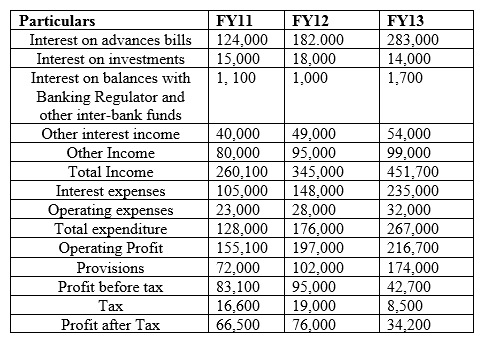 Balance Sheet
Balance Sheet 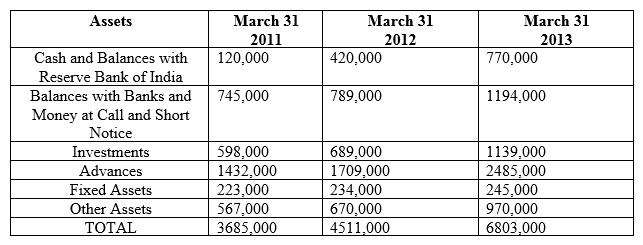
 The rating wise break-up of assets for FY11 is as follows:
The rating wise break-up of assets for FY11 is as follows: 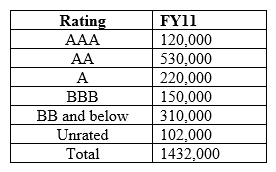 Cost to income ratio is best for which year
Cost to income ratio is best for which year
A) FY13
B) FY11
C) Same FY11 and FY12
D) FY12
 Balance Sheet
Balance Sheet 
 The rating wise break-up of assets for FY11 is as follows:
The rating wise break-up of assets for FY11 is as follows:  Cost to income ratio is best for which year
Cost to income ratio is best for which yearA) FY13
B) FY11
C) Same FY11 and FY12
D) FY12

Unlock Deck
Unlock for access to all 83 flashcards in this deck.
Unlock Deck
k this deck
21
Basket Default swaps could be
A) reference sectors could be from the same economy
B) reference sectors could be the entire global space
C) reference securities are from the same sector
A) reference sectors could be from the same economy
B) reference sectors could be the entire global space
C) reference securities are from the same sector

Unlock Deck
Unlock for access to all 83 flashcards in this deck.
Unlock Deck
k this deck
22
Which of the following shall not be used as a source of information for the credit risk assessment?
A) Annual Report
B) Reports issued by brokerages on companies
C) Analyst Presentations
D) Concall transcripts
A) Annual Report
B) Reports issued by brokerages on companies
C) Analyst Presentations
D) Concall transcripts

Unlock Deck
Unlock for access to all 83 flashcards in this deck.
Unlock Deck
k this deck
23
Z spreads in Callable bonds include:
A) Does not include premium for credit risk and call option price for prepayment risk.
B) Premium for credit risk and call option price for prepayment risk in included.
C) Premium for credit risk is only included.
D) Premium for call option price for prepayment risk os only included.
A) Does not include premium for credit risk and call option price for prepayment risk.
B) Premium for credit risk and call option price for prepayment risk in included.
C) Premium for credit risk is only included.
D) Premium for call option price for prepayment risk os only included.

Unlock Deck
Unlock for access to all 83 flashcards in this deck.
Unlock Deck
k this deck
24
The extension of a guarantee by company A to company B can lower the rating of___________
A) Company B
B) Both A and B
C) Guarantee has no impact on ratings of company A and company B
D) Company A
A) Company B
B) Both A and B
C) Guarantee has no impact on ratings of company A and company B
D) Company A

Unlock Deck
Unlock for access to all 83 flashcards in this deck.
Unlock Deck
k this deck
25
Change in priority ranking of reference obligations is:
A) Obligation acceleration
B) Obligation default
C) Restructuring
D) Repudiation
A) Obligation acceleration
B) Obligation default
C) Restructuring
D) Repudiation

Unlock Deck
Unlock for access to all 83 flashcards in this deck.
Unlock Deck
k this deck
26
Proportion of fee based income is examined as the same is an _____ efficient source of bank's profitability.
A) Interest based
B) Capital
C) Current
D) Fee Based
A) Interest based
B) Capital
C) Current
D) Fee Based

Unlock Deck
Unlock for access to all 83 flashcards in this deck.
Unlock Deck
k this deck
27
A coupon bond is trading at 110% of the USD 1000 par value. If the last interest payment was made one month ago and the coupon rate is 12%, the accrued interest on this bond is_______
A) 110
B) 100
C) 120
D) 10
A) 110
B) 100
C) 120
D) 10

Unlock Deck
Unlock for access to all 83 flashcards in this deck.
Unlock Deck
k this deck
28
Which of the following are types of bank guarantee?
A) Deferred and Term
B) Financial and Performance
C) Usance and Sight
A) Deferred and Term
B) Financial and Performance
C) Usance and Sight

Unlock Deck
Unlock for access to all 83 flashcards in this deck.
Unlock Deck
k this deck
29
Attributes of healthy cultural values exclude:
A) Experienced management.
B) Diversified sources of revenue.
C) Brand.
D) Healthy relationship with employees
A) Experienced management.
B) Diversified sources of revenue.
C) Brand.
D) Healthy relationship with employees

Unlock Deck
Unlock for access to all 83 flashcards in this deck.
Unlock Deck
k this deck
30
Which of the following is not one of the C in the 5 C Model?
A) Capacity
B) Capital
C) Covenants
D) Conditions
A) Capacity
B) Capital
C) Covenants
D) Conditions

Unlock Deck
Unlock for access to all 83 flashcards in this deck.
Unlock Deck
k this deck
31
In an industry there are only 20 firms and each of them has equal share. Compute Herfindahl Hirschman Index and state the level of concentration in the industry.
A) HHI = 500; High Concentration
B) HHI = 8000; low Concentration
C) HHI = 8000; High Concentration
D) HHI = 500; Low Concentration
A) HHI = 500; High Concentration
B) HHI = 8000; low Concentration
C) HHI = 8000; High Concentration
D) HHI = 500; Low Concentration

Unlock Deck
Unlock for access to all 83 flashcards in this deck.
Unlock Deck
k this deck
32
Which of the following statement is (are) correct? Statement 1: Industry analysis is the first and foremost step in the bottom up approach of analysis. Statement 2: Industry analysis would enable an analyst to figure out the relative positions of various market players and thereby make informed investment decisions.
A) Both are incorrect
B) Only Statement 1 is correct
C) Only Statement 2 is correct
D) Both are correct
A) Both are incorrect
B) Only Statement 1 is correct
C) Only Statement 2 is correct
D) Both are correct

Unlock Deck
Unlock for access to all 83 flashcards in this deck.
Unlock Deck
k this deck
33
Which of the following is a factor considered while evaluating resources profile for rating of bank?
A) Size and growth of deposits
B) All of the three
C) Deposit composition & stickiness
D) Geographic distribution of deposits
A) Size and growth of deposits
B) All of the three
C) Deposit composition & stickiness
D) Geographic distribution of deposits

Unlock Deck
Unlock for access to all 83 flashcards in this deck.
Unlock Deck
k this deck
34
For considering the assignment of probabilities, which of the following aspects are taken into account?
A) Economic cycle - bearish phase or boom
B) All of the other options
C) The date of valuation of assets on the financials
D) The nature and age of assets
A) Economic cycle - bearish phase or boom
B) All of the other options
C) The date of valuation of assets on the financials
D) The nature and age of assets

Unlock Deck
Unlock for access to all 83 flashcards in this deck.
Unlock Deck
k this deck
35
Risk in CDS price is reflective of
A) increase in probability of default
B) increase in interest rates
C) decrease in probability of default
D) increase in recovery rates
A) increase in probability of default
B) increase in interest rates
C) decrease in probability of default
D) increase in recovery rates

Unlock Deck
Unlock for access to all 83 flashcards in this deck.
Unlock Deck
k this deck
36
Under an advance factoring contract, following flow of money takes place: A: Factor pays a percentage of the invoice face value to the seller at the time of sale B: The remainder of the purchase price is held by factor until the payment by the account debtor is made. C: The cost associated with the transaction is paid upfront by the seller to the factoring agent.
A) Only B
B) A, B and C
C) Only C
D) Only A and B
A) Only B
B) A, B and C
C) Only C
D) Only A and B

Unlock Deck
Unlock for access to all 83 flashcards in this deck.
Unlock Deck
k this deck
37
An increase in the salaries of the bank employees due to new bank employee pay commission implemented by the Central Government will lead to deterioration of which of the following ratios: A: Cost to Income Ratio B: Net Interest Margin C: Core Spread
A) Only A
B) A B and C
C) Only B
D) Only C
A) Only A
B) A B and C
C) Only B
D) Only C

Unlock Deck
Unlock for access to all 83 flashcards in this deck.
Unlock Deck
k this deck
38
If you yield curve is humped and the medium rates drop, what will happen to the yield curve?
A) It will move from negative to positive
B) It will shift up in a uniform fashion
C) It will become steeper
D) It will flatten
A) It will move from negative to positive
B) It will shift up in a uniform fashion
C) It will become steeper
D) It will flatten

Unlock Deck
Unlock for access to all 83 flashcards in this deck.
Unlock Deck
k this deck
39
Which of the following statement is false?
A) DEF Ltd. has received a speculative grade rating as its outstanding rating is B+
B) Non-Convertible debenture of PQR Ltd. has a speculative rating since its outstanding rating is C
C) ABC Ltd. short term is BBB- for its commercial paper
D) XYZ has an investment grade rating as his outstanding rating is A1
A) DEF Ltd. has received a speculative grade rating as its outstanding rating is B+
B) Non-Convertible debenture of PQR Ltd. has a speculative rating since its outstanding rating is C
C) ABC Ltd. short term is BBB- for its commercial paper
D) XYZ has an investment grade rating as his outstanding rating is A1

Unlock Deck
Unlock for access to all 83 flashcards in this deck.
Unlock Deck
k this deck
40
In Steepening short term rates ______relative to long term rate
A) falls
B) rises
C) is independent of each other
D) remains constant
A) falls
B) rises
C) is independent of each other
D) remains constant

Unlock Deck
Unlock for access to all 83 flashcards in this deck.
Unlock Deck
k this deck
41
The most important metric for a bank is the Net Interest Income (NII) which is the difference between____income and____expense.
A) Interest; Total
B) Interest; Fee
C) Interest; Interest
D) Total; Total
A) Interest; Total
B) Interest; Fee
C) Interest; Interest
D) Total; Total

Unlock Deck
Unlock for access to all 83 flashcards in this deck.
Unlock Deck
k this deck
42
Which of the following is NOT a conceptual definition of credit risk on which credit models are based?
A) Default Mode Paradigm
B) Value-at-Risk paradigm
C) Mark-to-Market Paradigm
A) Default Mode Paradigm
B) Value-at-Risk paradigm
C) Mark-to-Market Paradigm

Unlock Deck
Unlock for access to all 83 flashcards in this deck.
Unlock Deck
k this deck
43
Statement 1: The Yields on the MBS PTCs are normally higher than the yields on the corporate bonds of similar ratings. Statement 2: The reason for difference in yields on the corporate bonds and similarly rated PTCs is on account of the optionality in the PTC, the unfamiliarity of the structure and uncertainties in respect of legal and structural issues. Which of the above statements is correct?
A) None of the statements
B) Both the statements
C) Only Statement 2 is correct
D) Only Statement 1 is correct
A) None of the statements
B) Both the statements
C) Only Statement 2 is correct
D) Only Statement 1 is correct

Unlock Deck
Unlock for access to all 83 flashcards in this deck.
Unlock Deck
k this deck
44
Which of the following factor is considered while undertaking management evaluation?
A) All of the other options
B) Corporate Strategy
C) Performance of group concerns
D) Past track record
A) All of the other options
B) Corporate Strategy
C) Performance of group concerns
D) Past track record

Unlock Deck
Unlock for access to all 83 flashcards in this deck.
Unlock Deck
k this deck
45
During FY13, Small Bazar, a leading retail company has sold three of its prime properties for a sum of USD 24 Million. The same had a carrying value of USD 30 Million. Analyst had considered the same as operating income and considered it to be part of operating expenses. However, she realized her mistake and recorded the loss as non-operating loss. Which of the following ratio will not change despite the correction? A) EBITDA Margins B) Interest Coverage C) PAT Margins D) Gross Profit Margin
A) B, C & D
B) A, B & C
C) B, C
D) All Ratios will change
A) B, C & D
B) A, B & C
C) B, C
D) All Ratios will change

Unlock Deck
Unlock for access to all 83 flashcards in this deck.
Unlock Deck
k this deck
46
The _______ cycle is the length of time between the company's outflow on raw materials and the manufacturing expenses and the inflow of cash from the sale of goods.
A) Cash flow mismatch
B) Money
C) Running
D) Operating
A) Cash flow mismatch
B) Money
C) Running
D) Operating

Unlock Deck
Unlock for access to all 83 flashcards in this deck.
Unlock Deck
k this deck
47
Which of the following is false in case of credit enhancements?
A) It reduces the default risk of the borrowing entity for the lender, thereby deteriorating the overall credit worthiness of the borrower
B) Credit enhancement could be implicit or explicit
C) Credit enhancement is a mechanism whereby external cash flows is extended by an entity which has a stringer credit profile, so that it benefits the fund raising entity
A) It reduces the default risk of the borrowing entity for the lender, thereby deteriorating the overall credit worthiness of the borrower
B) Credit enhancement could be implicit or explicit
C) Credit enhancement is a mechanism whereby external cash flows is extended by an entity which has a stringer credit profile, so that it benefits the fund raising entity

Unlock Deck
Unlock for access to all 83 flashcards in this deck.
Unlock Deck
k this deck
48
Based on the Moody's KMV model which of the following is not correct? A: Growth variables are important for default analysis. rapid growth will lead to lower probability of default and rapid decline will lead to higher probability of default. B: Activity ratios are relevant for default analysis. A large stock of inventories relative to sales will lead to a higher probability of default.
A) Only Statement A is correct
B) Both the statements are correct
C) None of the statements is correct
D) Only Statement B is correct
A) Only Statement A is correct
B) Both the statements are correct
C) None of the statements is correct
D) Only Statement B is correct

Unlock Deck
Unlock for access to all 83 flashcards in this deck.
Unlock Deck
k this deck
49
Bank A has an imaginary portfolio of USD 1000 Million distributed towards following four entities: 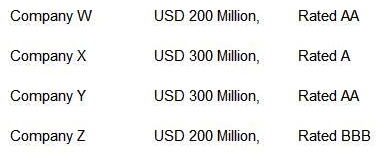 Bank A is stipulated to maintain a capital adequacy ratio of 11% on its risk weighted assets. It is being stipulated that the ratings for all the four entities is expected to be downgraded by 1 notch each. Estimate the amount of new capital required for Bank A?
Bank A is stipulated to maintain a capital adequacy ratio of 11% on its risk weighted assets. It is being stipulated that the ratings for all the four entities is expected to be downgraded by 1 notch each. Estimate the amount of new capital required for Bank A?
A) USD 93.5 Million
B) USD 38.5 Million
C) USD 55 Million
D) USD 850 Million
 Bank A is stipulated to maintain a capital adequacy ratio of 11% on its risk weighted assets. It is being stipulated that the ratings for all the four entities is expected to be downgraded by 1 notch each. Estimate the amount of new capital required for Bank A?
Bank A is stipulated to maintain a capital adequacy ratio of 11% on its risk weighted assets. It is being stipulated that the ratings for all the four entities is expected to be downgraded by 1 notch each. Estimate the amount of new capital required for Bank A?A) USD 93.5 Million
B) USD 38.5 Million
C) USD 55 Million
D) USD 850 Million

Unlock Deck
Unlock for access to all 83 flashcards in this deck.
Unlock Deck
k this deck
50
Project 1: Company X has a sugar mill at Philadelphia and is replicating same at Toronto. Project 2: Company Y has a sugar mill at Philadelphia and is increasing capacity from 100000 MT to 140000 MT per annum. What type of projects are Project 1 and Project 2?
A) Project 1: Diversification; Project 2: Forward Integration
B) Project 1: Expansion; Project 2: Forward Integration
C) Project 1: Diversification; Project 2: Expansion
D) Project 1: Expansion; Project 2: Expansion
A) Project 1: Diversification; Project 2: Forward Integration
B) Project 1: Expansion; Project 2: Forward Integration
C) Project 1: Diversification; Project 2: Expansion
D) Project 1: Expansion; Project 2: Expansion

Unlock Deck
Unlock for access to all 83 flashcards in this deck.
Unlock Deck
k this deck
51
Which of the following may lead to the deterioration in credit profile of a bank? Statement
1) Bank's Capital adequacy falling below regulatory requirement. Statement
2) Rise in Slippage ratio
A) None of the statement is correct
B) Both statement 1 and 2 are correct
C) Statement 1 is correct
D) Statement 2 is correct
1) Bank's Capital adequacy falling below regulatory requirement. Statement
2) Rise in Slippage ratio
A) None of the statement is correct
B) Both statement 1 and 2 are correct
C) Statement 1 is correct
D) Statement 2 is correct

Unlock Deck
Unlock for access to all 83 flashcards in this deck.
Unlock Deck
k this deck
52
Short term rates are determined by____________
A) All of the other options
B) Liquidity position caused by seasonal demand supply for credit
C) Foreign portfolio investment inflows and outflows
D) Bunching of tax and government payments
A) All of the other options
B) Liquidity position caused by seasonal demand supply for credit
C) Foreign portfolio investment inflows and outflows
D) Bunching of tax and government payments

Unlock Deck
Unlock for access to all 83 flashcards in this deck.
Unlock Deck
k this deck
53
Stand by letter of credits are typically taken as credit enhancement for___________
A) Commercial Paper
B) Long term Bond issues
C) Long term debenture issues
D) Bank debt
A) Commercial Paper
B) Long term Bond issues
C) Long term debenture issues
D) Bank debt

Unlock Deck
Unlock for access to all 83 flashcards in this deck.
Unlock Deck
k this deck
54
Step up upon feature will lead to
A) no change as step is not linked to issuers rating
B) positive basis because the bond holder is compensated
C) negative basis given that the bondholder is not compensated
D) Will lead to a change only if there is a linkage to the issuer's rating
A) no change as step is not linked to issuers rating
B) positive basis because the bond holder is compensated
C) negative basis given that the bondholder is not compensated
D) Will lead to a change only if there is a linkage to the issuer's rating

Unlock Deck
Unlock for access to all 83 flashcards in this deck.
Unlock Deck
k this deck
55
Butterfly strategy is a combination of
A) Ladder and Barbell on the same market sides
B) Barbell and Bullet on the opposite market sides
C) Barbell and Bullet on the same market sides
D) Ladder and barbell on the opposite market sides
A) Ladder and Barbell on the same market sides
B) Barbell and Bullet on the opposite market sides
C) Barbell and Bullet on the same market sides
D) Ladder and barbell on the opposite market sides

Unlock Deck
Unlock for access to all 83 flashcards in this deck.
Unlock Deck
k this deck
56
Awesome Mobile Ltd is a leading mobile seller who manufactures mobile phone under own brand Awesome. Which of the following is the biggest business risk for Awesome?
A) Technology Risk
B) Branding risk
C) Raw material price risk
D) Competition
A) Technology Risk
B) Branding risk
C) Raw material price risk
D) Competition

Unlock Deck
Unlock for access to all 83 flashcards in this deck.
Unlock Deck
k this deck
57
A holder of which of the following types of bonds is least likely to suffer from rising interest rates?
A) Floating rate bonds
B) Fixed rate bond
C) Zero-coupon bonds
A) Floating rate bonds
B) Fixed rate bond
C) Zero-coupon bonds

Unlock Deck
Unlock for access to all 83 flashcards in this deck.
Unlock Deck
k this deck
58
Which of the following is not an importance of the sovereign rating? A: To arrive at cost of lending to a country B: To set lower floor for the rating of the corporate and banks of the countries on international scale. C: For determining the risk levels for international investment portfolios
A) Only A and C
B) Only B
C) Only A and B
D) None of the three
A) Only A and C
B) Only B
C) Only A and B
D) None of the three

Unlock Deck
Unlock for access to all 83 flashcards in this deck.
Unlock Deck
k this deck
59
In a weakening economy, which of the following is least accurate?
A) Interest costs go up and create refunding risk for those who have bonds maturing which need to be rolled over.
B) Interest costs go up and create rate risk for have bonds maturing which need to be rolled over.
C) None of the other options.
D) Interest costs go up and create funding risk for those who have borowing plans lined up.
A) Interest costs go up and create refunding risk for those who have bonds maturing which need to be rolled over.
B) Interest costs go up and create rate risk for have bonds maturing which need to be rolled over.
C) None of the other options.
D) Interest costs go up and create funding risk for those who have borowing plans lined up.

Unlock Deck
Unlock for access to all 83 flashcards in this deck.
Unlock Deck
k this deck
60
Which of the following statements concerning having a CEO serve as chairman of the board is most accurate? Having a CEO also serve as chairman is considered:
A) poor corporate governance practice as having the CEO server as chairman is an inherent conflict when determining management compensation.
B) good corporate governance practice as the CEO is the best person to provide the board with information about the company's strategy and operations.
C) cannot be determined
D) poor corporate governance practice as having the CEO and chairman serve as separate positions ensures a properly-functioning board.
A) poor corporate governance practice as having the CEO server as chairman is an inherent conflict when determining management compensation.
B) good corporate governance practice as the CEO is the best person to provide the board with information about the company's strategy and operations.
C) cannot be determined
D) poor corporate governance practice as having the CEO and chairman serve as separate positions ensures a properly-functioning board.

Unlock Deck
Unlock for access to all 83 flashcards in this deck.
Unlock Deck
k this deck
61
Mr. A shares details of two bonds as follows: 
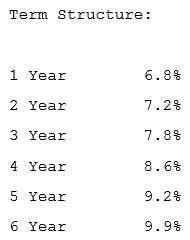 Determine the interpolated spread for Bond X and Bond Y?
Determine the interpolated spread for Bond X and Bond Y?
A) Bond X: 80 bps Bond Y: Negative
B) Bond X: 35 bps Bond Y: 5 bps
C) Bond X: 65 bps Bond Y: Nil
D) Bond X: 20 bps Bond Y: 20 bps

 Determine the interpolated spread for Bond X and Bond Y?
Determine the interpolated spread for Bond X and Bond Y?A) Bond X: 80 bps Bond Y: Negative
B) Bond X: 35 bps Bond Y: 5 bps
C) Bond X: 65 bps Bond Y: Nil
D) Bond X: 20 bps Bond Y: 20 bps

Unlock Deck
Unlock for access to all 83 flashcards in this deck.
Unlock Deck
k this deck
62
Satish Dhawan, a veteran fixed income trader is conducting interviews for the post of a junior fixed income trader. He interviewed four candidates Adam, Balkrishnan, Catherine and Deepak and following are the answers to his questions. Question 1: Tell something about Option Adjusted Spread Adam: OAS is applicable only to bond which do not have any options attached to it. It is for the plain bonds. Balkishna: In bonds with embedded options, AS reflects not only the credit risk but also reflects prepayment risk over and above the benchmark. Catherine: Sincespreads are calculated to know the level of credit risk in the bound, OAS is difference between in the Z spread and price of a call option for a callable bond. Deepark: For callable bond OAS will be lower than Z Spread. Question 2 : This is a spread that must be added to the benchmark zero rate curve in a parallel shift so that the sum of the risky bond's discounted cash flows equals its current market price. Which Spread I am talking about? Adam: Z Spread Balkrishna: Nominal Spread Catherine: Option Adjusted Spread Deepark: Asset Swap Spread Question 3 : What do you know about Interpolated spread and yield spread? Adam: Yield spread is the difference between the YTM of a risky bond and the YTM of an on-the-run treasury benchmark bond whose maturity is closest, but not identical to that of risky bond. Interpolated spread is the spread between the YTM of risky bond and the YTM of same maturity treasury benchmark, which is interpolated from the two nearest on-the-run treasury securities. Balkrishna: Interpolated spread is preferred to yield spread because the latter has the maturity mismatch, which leads to error if the yield curve is not flat and the benchmark security changes over time, leading to inconsistency. Catherine: Interpolated spread takes account the shape of the benchmark yield curve and therefore better than yield spread. Deepak: Both Interpolated Spread and Yield Spread rely on YTM which suffers from drawbacks and inconsistencies such as the assumption of flat yield curve and reinvestment at YTM itself. Then Satish gave following information related to the benchmark YTMs:  An investor decides to invest in the bond futures and has an outlook that the term structure curve would steepen. What should be his trading strategy?
An investor decides to invest in the bond futures and has an outlook that the term structure curve would steepen. What should be his trading strategy?
A) Sell futures on short-maturity underlying, Buy futures on long-maturity underlying
B) Buy futures on short-maturity underlying, Buy futures on long-maturity underlying and Sell futures on middle-maturity underlying
C) Buy futures on short-maturity underlying, Sell futures on long-maturity underlying.
D) Sell futures on short-maturity underlying, Sell futures on long-maturity underlying and Buy futures on middle-maturity underlying.
 An investor decides to invest in the bond futures and has an outlook that the term structure curve would steepen. What should be his trading strategy?
An investor decides to invest in the bond futures and has an outlook that the term structure curve would steepen. What should be his trading strategy?A) Sell futures on short-maturity underlying, Buy futures on long-maturity underlying
B) Buy futures on short-maturity underlying, Buy futures on long-maturity underlying and Sell futures on middle-maturity underlying
C) Buy futures on short-maturity underlying, Sell futures on long-maturity underlying.
D) Sell futures on short-maturity underlying, Sell futures on long-maturity underlying and Buy futures on middle-maturity underlying.

Unlock Deck
Unlock for access to all 83 flashcards in this deck.
Unlock Deck
k this deck
63
Based on the common size statement analysis which of the following statement regarding employee cost is correct? 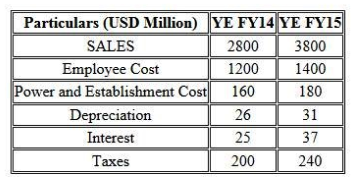
A) The employee cost is expected to contribute 8% to decrease in PAT in FY15
B) The employee cost is expected to contribute 7% to decrease in PAT in FY15
C) The employee cost is expected to contribute 6% to decrease in PAT in FY15
D) The employee cost is expected to contribute 5% to decrease in PAT in FY15

A) The employee cost is expected to contribute 8% to decrease in PAT in FY15
B) The employee cost is expected to contribute 7% to decrease in PAT in FY15
C) The employee cost is expected to contribute 6% to decrease in PAT in FY15
D) The employee cost is expected to contribute 5% to decrease in PAT in FY15

Unlock Deck
Unlock for access to all 83 flashcards in this deck.
Unlock Deck
k this deck
64
Satish Dhawan, a veteran fixed income trader is conducting interviews for the post of a junior fixed income trader. He interviewed four candidates Adam, Balkrishnan, Catherine and Deepak and following are the answers to his questions. Question 1: Tell something about Option Adjusted Spread Adam: OAS is applicable only to bond which do not have any options attached to it. It is for the plain bonds. Balkishna: In bonds with embedded options, AS reflects not only the credit risk but also reflects prepayment risk over and above the benchmark. Catherine: Sincespreads are calculated to know the level of credit risk in the bound, OAS is difference between in the Z spread and price of a call option for a callable bond. Deepark: For callable bond OAS will be lower than Z Spread. Question 2 : This is a spread that must be added to the benchmark zero rate curve in a parallel shift so that the sum of the risky bond's discounted cash flows equals its current market price. Which Spread I am talking about? Adam: Z Spread Balkrishna: Nominal Spread Catherine: Option Adjusted Spread Deepark: Asset Swap Spread Question 3 : What do you know about Interpolated spread and yield spread? Adam: Yield spread is the difference between the YTM of a risky bond and the YTM of an on-the-run treasury benchmark bond whose maturity is closest, but not identical to that of risky bond. Interpolated spread is the spread between the YTM of risky bond and the YTM of same maturity treasury benchmark, which is interpolated from the two nearest on-the-run treasury securities. Balkrishna: Interpolated spread is preferred to yield spread because the latter has the maturity mismatch, which leads to error if the yield curve is not flat and the benchmark security changes over time, leading to inconsistency. Catherine: Interpolated spread takes account the shape of the benchmark yield curve and therefore better than yield spread. Deepak: Both Interpolated Spread and Yield Spread rely on YTM which suffers from drawbacks and inconsistencies such as the assumption of flat yield curve and reinvestment at YTM itself. Then Satish gave following information related to the benchmark YTMs:  Which of the modified statement of Balkrishna will be a correct statement?
Which of the modified statement of Balkrishna will be a correct statement?
A) In bonds with embedded options, Nominal Spread reflects not only the credit risk but also reflects prepayment risk over and above the benchmark.
B) In bonds with embedded options, spread reflects not only the credit risk but also reflects prepayment risk over and above the benchmark.
C) None of the three.
D) In bonds with embedded options, Z Spread reflects not only the credit risk but also reflects prepayment risk over and above the benchmark.
 Which of the modified statement of Balkrishna will be a correct statement?
Which of the modified statement of Balkrishna will be a correct statement?A) In bonds with embedded options, Nominal Spread reflects not only the credit risk but also reflects prepayment risk over and above the benchmark.
B) In bonds with embedded options, spread reflects not only the credit risk but also reflects prepayment risk over and above the benchmark.
C) None of the three.
D) In bonds with embedded options, Z Spread reflects not only the credit risk but also reflects prepayment risk over and above the benchmark.

Unlock Deck
Unlock for access to all 83 flashcards in this deck.
Unlock Deck
k this deck
65
Following is information related banks: Auckland Ltd is a public sector bank operating with about 120 branches across India. The bank has been in business since 1971 and has about 40% branches in rural areas and about 75% of all branches are in Western India. On the basis of the size, Auckland Ltd will be ranked at number 31 amongst 40 banks in India. Although top management has appointment period of 5 years, generally they retire on ach sieving age of 60 years with an average tenure of only 2 years at the top job. Profit and Loss Account 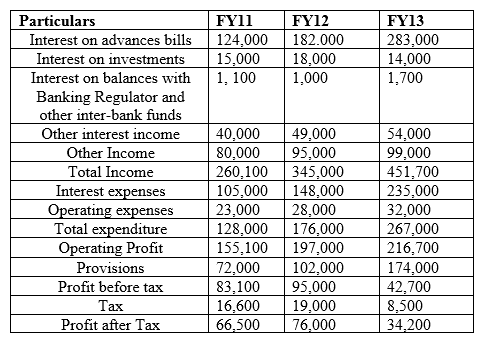 Balance Sheet
Balance Sheet 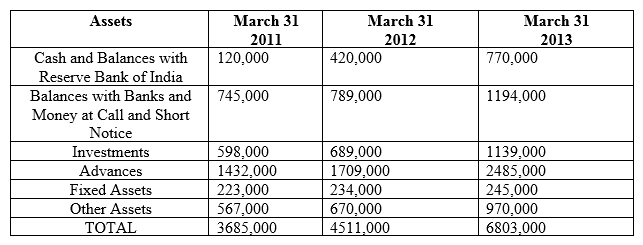
 The rating wise break-up of assets for FY11 is as follows:
The rating wise break-up of assets for FY11 is as follows: 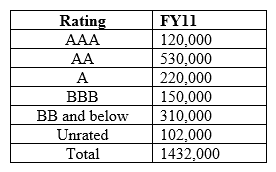 The core spreads for FY13 as compared to FY12 have:
The core spreads for FY13 as compared to FY12 have:
A) Expanded by 136 bps
B) Contracted by 327 bps
C) Contracted by 136 bps
D) Expanded by 191 bps
 Balance Sheet
Balance Sheet 
 The rating wise break-up of assets for FY11 is as follows:
The rating wise break-up of assets for FY11 is as follows:  The core spreads for FY13 as compared to FY12 have:
The core spreads for FY13 as compared to FY12 have:A) Expanded by 136 bps
B) Contracted by 327 bps
C) Contracted by 136 bps
D) Expanded by 191 bps

Unlock Deck
Unlock for access to all 83 flashcards in this deck.
Unlock Deck
k this deck
66
Provisioning Coverage Ratio (PCR) is essentially the ratio of provisioning to ______ and indicates the extent of funds a bank has kept aside to cover loan losses.
A) total loan portfolio
B) gross non-performing assets
C) total assets
A) total loan portfolio
B) gross non-performing assets
C) total assets

Unlock Deck
Unlock for access to all 83 flashcards in this deck.
Unlock Deck
k this deck
67
Scott is a credit analyst with one of the credit rating agencies in India. He was looking in Oil and Gas Industry companies and has presented brief financials for following 4 entities:  Which of the following statements is incorrect?
Which of the following statements is incorrect?
A) B Ltd has higher EBITDA margins as compared to C Ltd.
B) D Ltd has higher EBITDA margins as competed to B Ltd.
C) C Ltd has worst total debt to EBITDA ratio.
D) B Ltd has worst interest coverage ratio.
 Which of the following statements is incorrect?
Which of the following statements is incorrect?A) B Ltd has higher EBITDA margins as compared to C Ltd.
B) D Ltd has higher EBITDA margins as competed to B Ltd.
C) C Ltd has worst total debt to EBITDA ratio.
D) B Ltd has worst interest coverage ratio.

Unlock Deck
Unlock for access to all 83 flashcards in this deck.
Unlock Deck
k this deck
68
The following information pertains to bonds: 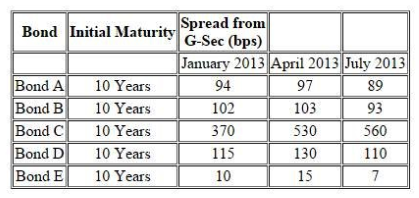 Further following information is available about a particular bond 'Bond F' There is a 10.25% risky bond with a maturity of 2.25% year(s) its current price is INR105.31, which corresponds to YTM of 9.22%. The following are the benchmark YTMs.
Further following information is available about a particular bond 'Bond F' There is a 10.25% risky bond with a maturity of 2.25% year(s) its current price is INR105.31, which corresponds to YTM of 9.22%. The following are the benchmark YTMs.  Following are the relevance of Industry Analysis: Statement 1: Evaluating Industry risk is the first and foremost step for top down approach of analysis. Statement 2: Industry Analysis is relevant for analyzing the industry life cycle, which is highly important from the perspective of an investor or lender. State which is/are correct?
Following are the relevance of Industry Analysis: Statement 1: Evaluating Industry risk is the first and foremost step for top down approach of analysis. Statement 2: Industry Analysis is relevant for analyzing the industry life cycle, which is highly important from the perspective of an investor or lender. State which is/are correct?
A) Both are incorrect
B) Both are correct
C) Only Statement 2 is correct
D) Only Statement 1 is correct
 Further following information is available about a particular bond 'Bond F' There is a 10.25% risky bond with a maturity of 2.25% year(s) its current price is INR105.31, which corresponds to YTM of 9.22%. The following are the benchmark YTMs.
Further following information is available about a particular bond 'Bond F' There is a 10.25% risky bond with a maturity of 2.25% year(s) its current price is INR105.31, which corresponds to YTM of 9.22%. The following are the benchmark YTMs.  Following are the relevance of Industry Analysis: Statement 1: Evaluating Industry risk is the first and foremost step for top down approach of analysis. Statement 2: Industry Analysis is relevant for analyzing the industry life cycle, which is highly important from the perspective of an investor or lender. State which is/are correct?
Following are the relevance of Industry Analysis: Statement 1: Evaluating Industry risk is the first and foremost step for top down approach of analysis. Statement 2: Industry Analysis is relevant for analyzing the industry life cycle, which is highly important from the perspective of an investor or lender. State which is/are correct?A) Both are incorrect
B) Both are correct
C) Only Statement 2 is correct
D) Only Statement 1 is correct

Unlock Deck
Unlock for access to all 83 flashcards in this deck.
Unlock Deck
k this deck
69
"Following four entities operate in the Indian IT and BPO space. They all are into same segment of providing off-shore analytical services. They all operate on the labour cost-arbitrage in India and the countries of their clients. Following information pertains for the year ended March 31, 201 3. 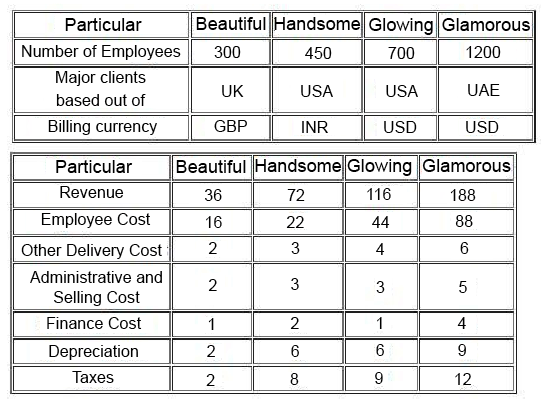
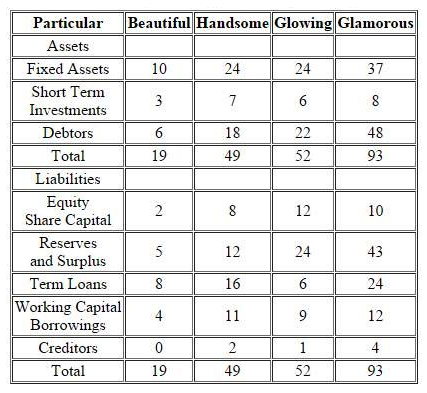 The year FY13, was typically a good year for Indian IT companies. For FY14, the economic analysts have given following predictions about the IT Industry: A) It is expected that INR will appreciate sharply against other USD. B) Given high inflation and attrition in IT Industry in India, the wages of IT sector employees will increase more sharply than Inflation and general wage rise in country. C) US Congress will be passing a bill which restricts the outsourcing to third world countries like India. While analyzing the four entities, you come across following findings related to Glowing: Glowing is promoted by Mr.M R Bhutta, who has earlier promoted two other business ventures, He started with ABC Entertainment Ltd in 1996 and was promoter and MD of the company. ABC was a listed entity and its share price had sharp movements at the time of stock market scam in late 1990s. In 1999, Mr.Bhutta sold his entire stake and resigned from the post of MD. The stock price declined by about 90% in coming days and has never recovered. Later on in 2003, Mr.Bhutta again promoted a new business, Klear Publications Ltd (KCL) an in the business of magazine publication. The entity had come out with a successful IPO and raised money from public. Thereafter it ran into troubles and reported losses. In 2009, Mr.Bhutta went on to exit this business as well by selling stake to other promoter(s). There have been reports in both instances with allegations that promoters have siphoned off money from listed entities to other group entities, however, nothing has been proved in any court." Which of the following risks do not exist for Indian IT industry?
The year FY13, was typically a good year for Indian IT companies. For FY14, the economic analysts have given following predictions about the IT Industry: A) It is expected that INR will appreciate sharply against other USD. B) Given high inflation and attrition in IT Industry in India, the wages of IT sector employees will increase more sharply than Inflation and general wage rise in country. C) US Congress will be passing a bill which restricts the outsourcing to third world countries like India. While analyzing the four entities, you come across following findings related to Glowing: Glowing is promoted by Mr.M R Bhutta, who has earlier promoted two other business ventures, He started with ABC Entertainment Ltd in 1996 and was promoter and MD of the company. ABC was a listed entity and its share price had sharp movements at the time of stock market scam in late 1990s. In 1999, Mr.Bhutta sold his entire stake and resigned from the post of MD. The stock price declined by about 90% in coming days and has never recovered. Later on in 2003, Mr.Bhutta again promoted a new business, Klear Publications Ltd (KCL) an in the business of magazine publication. The entity had come out with a successful IPO and raised money from public. Thereafter it ran into troubles and reported losses. In 2009, Mr.Bhutta went on to exit this business as well by selling stake to other promoter(s). There have been reports in both instances with allegations that promoters have siphoned off money from listed entities to other group entities, however, nothing has been proved in any court." Which of the following risks do not exist for Indian IT industry?
A) Raw material price risk, Exchange rate Risk
B) Interest rate risk, Skilled Manpower Risk
C) Exchange Rate Risk, Interest rate risk
D) Domestic and international regulatory risk, technological risk

 The year FY13, was typically a good year for Indian IT companies. For FY14, the economic analysts have given following predictions about the IT Industry: A) It is expected that INR will appreciate sharply against other USD. B) Given high inflation and attrition in IT Industry in India, the wages of IT sector employees will increase more sharply than Inflation and general wage rise in country. C) US Congress will be passing a bill which restricts the outsourcing to third world countries like India. While analyzing the four entities, you come across following findings related to Glowing: Glowing is promoted by Mr.M R Bhutta, who has earlier promoted two other business ventures, He started with ABC Entertainment Ltd in 1996 and was promoter and MD of the company. ABC was a listed entity and its share price had sharp movements at the time of stock market scam in late 1990s. In 1999, Mr.Bhutta sold his entire stake and resigned from the post of MD. The stock price declined by about 90% in coming days and has never recovered. Later on in 2003, Mr.Bhutta again promoted a new business, Klear Publications Ltd (KCL) an in the business of magazine publication. The entity had come out with a successful IPO and raised money from public. Thereafter it ran into troubles and reported losses. In 2009, Mr.Bhutta went on to exit this business as well by selling stake to other promoter(s). There have been reports in both instances with allegations that promoters have siphoned off money from listed entities to other group entities, however, nothing has been proved in any court." Which of the following risks do not exist for Indian IT industry?
The year FY13, was typically a good year for Indian IT companies. For FY14, the economic analysts have given following predictions about the IT Industry: A) It is expected that INR will appreciate sharply against other USD. B) Given high inflation and attrition in IT Industry in India, the wages of IT sector employees will increase more sharply than Inflation and general wage rise in country. C) US Congress will be passing a bill which restricts the outsourcing to third world countries like India. While analyzing the four entities, you come across following findings related to Glowing: Glowing is promoted by Mr.M R Bhutta, who has earlier promoted two other business ventures, He started with ABC Entertainment Ltd in 1996 and was promoter and MD of the company. ABC was a listed entity and its share price had sharp movements at the time of stock market scam in late 1990s. In 1999, Mr.Bhutta sold his entire stake and resigned from the post of MD. The stock price declined by about 90% in coming days and has never recovered. Later on in 2003, Mr.Bhutta again promoted a new business, Klear Publications Ltd (KCL) an in the business of magazine publication. The entity had come out with a successful IPO and raised money from public. Thereafter it ran into troubles and reported losses. In 2009, Mr.Bhutta went on to exit this business as well by selling stake to other promoter(s). There have been reports in both instances with allegations that promoters have siphoned off money from listed entities to other group entities, however, nothing has been proved in any court." Which of the following risks do not exist for Indian IT industry?A) Raw material price risk, Exchange rate Risk
B) Interest rate risk, Skilled Manpower Risk
C) Exchange Rate Risk, Interest rate risk
D) Domestic and international regulatory risk, technological risk

Unlock Deck
Unlock for access to all 83 flashcards in this deck.
Unlock Deck
k this deck
70
__________Strategy consists of buying a bond with maturity longer than the investment horizon (for investor) or buying a long-maturity bond with short-term funding through repo (for speculator).
A) Barbell, Ladder and Butterfly
B) Yield Spread Anticipation
C) Rate Anticipation with Maturity Mismatch
D) Riding the yield curve
A) Barbell, Ladder and Butterfly
B) Yield Spread Anticipation
C) Rate Anticipation with Maturity Mismatch
D) Riding the yield curve

Unlock Deck
Unlock for access to all 83 flashcards in this deck.
Unlock Deck
k this deck
71
Ms. Mary Brown is a credit rating analyst. She had prepared a detailed report on one of her client, FlyHigh Airlines Ltd, a company operating chartered aircrafts in India. As she was heading for a meeting with her superior on the matter, coffee spilled over her set of prepared paper(s). As she was getting late for meeting, instead of preparing entire set she could recollect few numbers from her memory and reconstructed following partial financial table: 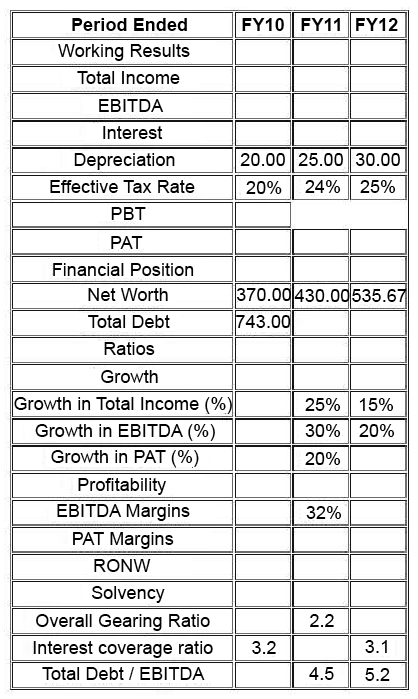 Compute Interest for FY10 and FY12?
Compute Interest for FY10 and FY12?
A) Insufficient Information to compute
B) FY10: INR50.53 Million; FY12:INR81.38 Million
C) FY10: INR161.71 Million; FY12: INR252.27 Million
D) FY10: INR17.47 Million; FY12:INR782.03 Million
 Compute Interest for FY10 and FY12?
Compute Interest for FY10 and FY12?A) Insufficient Information to compute
B) FY10: INR50.53 Million; FY12:INR81.38 Million
C) FY10: INR161.71 Million; FY12: INR252.27 Million
D) FY10: INR17.47 Million; FY12:INR782.03 Million

Unlock Deck
Unlock for access to all 83 flashcards in this deck.
Unlock Deck
k this deck
72
Case Facts as on March 31, 2012 Mark Construction Company (MCC) has bagged a contract for construction of a large dam and hydro power project on river Shiva in Madhya Pradesh (MP). The project is also of relevance from the irrigation perspective due to its location and as per the agreement MCC will have to undertake construction of web of canals, approach road to dam, power house and other ancillary units. MCC is promoted by Mr. Thomas Mark, who is a MP from the ruling party which recently formed government in MP. Historically, MCC has been engaged into construction of rural roads, small bridges and railway platforms on contract basis for the Government. MCC will have a separate special purpose vehicle (SPV) floated for this venture. The hydro power project comes under the public private partnership scheme of the Government of MP, where in the private partner builds owns operates and transfers (BOOT) the hydro power plant. The detailed terms of the hydro power project agreement are as follows:
1) The construction of the dam, canals and hydro power plant shall be undertaken by the contractor. The Government of MP will have to acquire land which will submerge on construction of dam and shall rehabilitate the owners of land.
2) MCC shall have right to operate the hydro power project from date of commencement of commercial operations (DCCO) for a period of 20 years and shall transfer the project to Government thereafter. Further, SPV shall be tax exempt for a period of five years from DCCO i.e. FY17-FY21.
3)The power project is of 600 megawatts (MW) shall comprise 4 units of 150 MW each. The estimated cost of project is about INR3, 500 Million to be spent over a period of 4 year(s) the project is estimated to be commercially operational by April 1, 2016 with two units operational om same day and one unit each will be operational on April 1, 2017 and April 1, 2018.
4)Means of finance: Means of Finance INR Million Government Aid (To be classified as Equity) 500Equity 900 Debt 2100
Means of Finance INR Million Government Aid (To be classified as Equity) 500Equity 900 Debt 2100
5)Amount if expenditure estimated in various years is as follows: Debt shall bear a fixed rate of interest of 10% and all interest till DCCO shall be added to the principal. The expected principal along with capitalized interest is expected to be INR2, 400 Million (i.e.INR2100 Million debt plus INR300 Million capitalized interest). The repayment of the same shall be in 12 equated annual installments starting from FY17. Brief projections for the period of FY17 to FY21 are given below: Developments as on March 31, 2015 The project manager for the SPV made following comments at a press conferee on March 31, 2015: As you all are aware, we were running bang on schedule till we last met on December 21, 2014.From today we are just left with one more year to complete the project in time. However, the flash floods which struck our dam site on this March 15, 2015 have created havoc in the region. I shall not point out the loss of lives in the region as you all are well aware of those. Our project has also been badly hit due to the same and we have been assessing the damage over the last one week. After analyzing damage, we have made changes in project schedule. Now we will be making only one unit of 150 MW operational on April 1, 2016 and 1 unit each will be added in each of subsequent year(s). Development as on September 30, 2015 Post the flash floods, lot of environmentalists started raising issues of changes in environment due to construction of large number of dams. A few Public Interest Litigations (PILs) have been filed in various courts. Honorable High Court of MP on September 27, 2015, banned construction of any dams in the region and banned permissions for new dams till next hearing scheduled on November 30, 201
Developments as on March 31, 2015 The project manager for the SPV made following comments at a press conferee on March 31, 2015: As you all are aware, we were running bang on schedule till we last met on December 21, 2014.From today we are just left with one more year to complete the project in time. However, the flash floods which struck our dam site on this March 15, 2015 have created havoc in the region. I shall not point out the loss of lives in the region as you all are well aware of those. Our project has also been badly hit due to the same and we have been assessing the damage over the last one week. After analyzing damage, we have made changes in project schedule. Now we will be making only one unit of 150 MW operational on April 1, 2016 and 1 unit each will be added in each of subsequent year(s). Development as on September 30, 2015 Post the flash floods, lot of environmentalists started raising issues of changes in environment due to construction of large number of dams. A few Public Interest Litigations (PILs) have been filed in various courts. Honorable High Court of MP on September 27, 2015, banned construction of any dams in the region and banned permissions for new dams till next hearing scheduled on November 30, 201
5)MCC in its press release has indicated that they will apply to the higher court on the matter. Based on the initial projections, do scenario analysis assuming only 75% capacity is utilized in FY17 and FY18 and thereby revenues will be proportionally reduced. Compute DSCR under such scenario for FY17 and FY18, assuming other things remain constant?
A) FY17: 0.85; FY18: 1.26
B) FY17: 0.74; FY18: 1.09
C) FY17:1.35; FY18: 2.09
D) FY17:0.98; FY18: 1.46
1) The construction of the dam, canals and hydro power plant shall be undertaken by the contractor. The Government of MP will have to acquire land which will submerge on construction of dam and shall rehabilitate the owners of land.
2) MCC shall have right to operate the hydro power project from date of commencement of commercial operations (DCCO) for a period of 20 years and shall transfer the project to Government thereafter. Further, SPV shall be tax exempt for a period of five years from DCCO i.e. FY17-FY21.
3)The power project is of 600 megawatts (MW) shall comprise 4 units of 150 MW each. The estimated cost of project is about INR3, 500 Million to be spent over a period of 4 year(s) the project is estimated to be commercially operational by April 1, 2016 with two units operational om same day and one unit each will be operational on April 1, 2017 and April 1, 2018.
4)Means of finance:
 Means of Finance INR Million Government Aid (To be classified as Equity) 500Equity 900 Debt 2100
Means of Finance INR Million Government Aid (To be classified as Equity) 500Equity 900 Debt 21005)Amount if expenditure estimated in various years is as follows: Debt shall bear a fixed rate of interest of 10% and all interest till DCCO shall be added to the principal. The expected principal along with capitalized interest is expected to be INR2, 400 Million (i.e.INR2100 Million debt plus INR300 Million capitalized interest). The repayment of the same shall be in 12 equated annual installments starting from FY17. Brief projections for the period of FY17 to FY21 are given below:
 Developments as on March 31, 2015 The project manager for the SPV made following comments at a press conferee on March 31, 2015: As you all are aware, we were running bang on schedule till we last met on December 21, 2014.From today we are just left with one more year to complete the project in time. However, the flash floods which struck our dam site on this March 15, 2015 have created havoc in the region. I shall not point out the loss of lives in the region as you all are well aware of those. Our project has also been badly hit due to the same and we have been assessing the damage over the last one week. After analyzing damage, we have made changes in project schedule. Now we will be making only one unit of 150 MW operational on April 1, 2016 and 1 unit each will be added in each of subsequent year(s). Development as on September 30, 2015 Post the flash floods, lot of environmentalists started raising issues of changes in environment due to construction of large number of dams. A few Public Interest Litigations (PILs) have been filed in various courts. Honorable High Court of MP on September 27, 2015, banned construction of any dams in the region and banned permissions for new dams till next hearing scheduled on November 30, 201
Developments as on March 31, 2015 The project manager for the SPV made following comments at a press conferee on March 31, 2015: As you all are aware, we were running bang on schedule till we last met on December 21, 2014.From today we are just left with one more year to complete the project in time. However, the flash floods which struck our dam site on this March 15, 2015 have created havoc in the region. I shall not point out the loss of lives in the region as you all are well aware of those. Our project has also been badly hit due to the same and we have been assessing the damage over the last one week. After analyzing damage, we have made changes in project schedule. Now we will be making only one unit of 150 MW operational on April 1, 2016 and 1 unit each will be added in each of subsequent year(s). Development as on September 30, 2015 Post the flash floods, lot of environmentalists started raising issues of changes in environment due to construction of large number of dams. A few Public Interest Litigations (PILs) have been filed in various courts. Honorable High Court of MP on September 27, 2015, banned construction of any dams in the region and banned permissions for new dams till next hearing scheduled on November 30, 2015)MCC in its press release has indicated that they will apply to the higher court on the matter. Based on the initial projections, do scenario analysis assuming only 75% capacity is utilized in FY17 and FY18 and thereby revenues will be proportionally reduced. Compute DSCR under such scenario for FY17 and FY18, assuming other things remain constant?
A) FY17: 0.85; FY18: 1.26
B) FY17: 0.74; FY18: 1.09
C) FY17:1.35; FY18: 2.09
D) FY17:0.98; FY18: 1.46

Unlock Deck
Unlock for access to all 83 flashcards in this deck.
Unlock Deck
k this deck
73
"Following four entities operate in the Indian IT and BPO space. They all are into same segment of providing off-shore analytical services. They all operate on the labour cost-arbitrage in India and the countries of their clients. Following information pertains for the year ended March 31, 201 3. 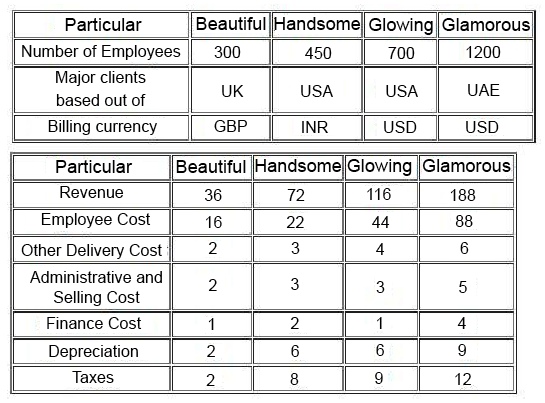
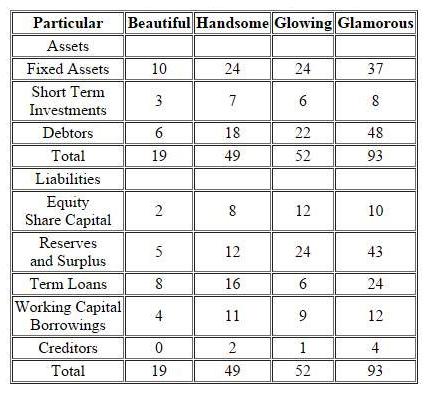 The year FY13, was typically a good year for Indian IT companies. For FY14, the economic analysts have given following predictions about the IT Industry: A) It is expected that INR will appreciate sharply against other USD. B) Given high inflation and attrition in IT Industry in India, the wages of IT sector employees will increase more sharply than Inflation and general wage rise in country. C) US Congress will be passing a bill which restricts the outsourcing to third world countries like India. While analyzing the four entities, you come across following findings related to Glowing: Glowing is promoted by Mr.M R Bhutta, who has earlier promoted two other business ventures, He started with ABC Entertainment Ltd in 1996 and was promoter and MD of the company. ABC was a listed entity and its share price had sharp movements at the time of stock market scam in late 1990s. In 1999, Mr. Bhutta sold his entire stake and resigned from the post of MD. The stock price declined by about 90% in coming days and has never recovered. Later on in 2003, Mr. Bhutta again promoted a new business, Klear Publications Ltd (KCL) an in the business of magazine publication. The entity had come out with a successful IPO and raised money from public. Thereafter it ran into troubles and reported losses. In 2009, Mr. Bhutta went on to exit this business as well by selling stake to other promoter(s). There have been reports in both instances with allegations that promoters have siphoned off money from listed entities to other group entities, however, nothing has been proved in any court." Which entity is best in terms of overall gearing ratio and net gearing ratio respectively:
The year FY13, was typically a good year for Indian IT companies. For FY14, the economic analysts have given following predictions about the IT Industry: A) It is expected that INR will appreciate sharply against other USD. B) Given high inflation and attrition in IT Industry in India, the wages of IT sector employees will increase more sharply than Inflation and general wage rise in country. C) US Congress will be passing a bill which restricts the outsourcing to third world countries like India. While analyzing the four entities, you come across following findings related to Glowing: Glowing is promoted by Mr.M R Bhutta, who has earlier promoted two other business ventures, He started with ABC Entertainment Ltd in 1996 and was promoter and MD of the company. ABC was a listed entity and its share price had sharp movements at the time of stock market scam in late 1990s. In 1999, Mr. Bhutta sold his entire stake and resigned from the post of MD. The stock price declined by about 90% in coming days and has never recovered. Later on in 2003, Mr. Bhutta again promoted a new business, Klear Publications Ltd (KCL) an in the business of magazine publication. The entity had come out with a successful IPO and raised money from public. Thereafter it ran into troubles and reported losses. In 2009, Mr. Bhutta went on to exit this business as well by selling stake to other promoter(s). There have been reports in both instances with allegations that promoters have siphoned off money from listed entities to other group entities, however, nothing has been proved in any court." Which entity is best in terms of overall gearing ratio and net gearing ratio respectively:
A) Glowing and Beautiful
B) Handsome and Handsome
C) Glamorous and Glowing
D) Glamorous and Glamorous

 The year FY13, was typically a good year for Indian IT companies. For FY14, the economic analysts have given following predictions about the IT Industry: A) It is expected that INR will appreciate sharply against other USD. B) Given high inflation and attrition in IT Industry in India, the wages of IT sector employees will increase more sharply than Inflation and general wage rise in country. C) US Congress will be passing a bill which restricts the outsourcing to third world countries like India. While analyzing the four entities, you come across following findings related to Glowing: Glowing is promoted by Mr.M R Bhutta, who has earlier promoted two other business ventures, He started with ABC Entertainment Ltd in 1996 and was promoter and MD of the company. ABC was a listed entity and its share price had sharp movements at the time of stock market scam in late 1990s. In 1999, Mr. Bhutta sold his entire stake and resigned from the post of MD. The stock price declined by about 90% in coming days and has never recovered. Later on in 2003, Mr. Bhutta again promoted a new business, Klear Publications Ltd (KCL) an in the business of magazine publication. The entity had come out with a successful IPO and raised money from public. Thereafter it ran into troubles and reported losses. In 2009, Mr. Bhutta went on to exit this business as well by selling stake to other promoter(s). There have been reports in both instances with allegations that promoters have siphoned off money from listed entities to other group entities, however, nothing has been proved in any court." Which entity is best in terms of overall gearing ratio and net gearing ratio respectively:
The year FY13, was typically a good year for Indian IT companies. For FY14, the economic analysts have given following predictions about the IT Industry: A) It is expected that INR will appreciate sharply against other USD. B) Given high inflation and attrition in IT Industry in India, the wages of IT sector employees will increase more sharply than Inflation and general wage rise in country. C) US Congress will be passing a bill which restricts the outsourcing to third world countries like India. While analyzing the four entities, you come across following findings related to Glowing: Glowing is promoted by Mr.M R Bhutta, who has earlier promoted two other business ventures, He started with ABC Entertainment Ltd in 1996 and was promoter and MD of the company. ABC was a listed entity and its share price had sharp movements at the time of stock market scam in late 1990s. In 1999, Mr. Bhutta sold his entire stake and resigned from the post of MD. The stock price declined by about 90% in coming days and has never recovered. Later on in 2003, Mr. Bhutta again promoted a new business, Klear Publications Ltd (KCL) an in the business of magazine publication. The entity had come out with a successful IPO and raised money from public. Thereafter it ran into troubles and reported losses. In 2009, Mr. Bhutta went on to exit this business as well by selling stake to other promoter(s). There have been reports in both instances with allegations that promoters have siphoned off money from listed entities to other group entities, however, nothing has been proved in any court." Which entity is best in terms of overall gearing ratio and net gearing ratio respectively:A) Glowing and Beautiful
B) Handsome and Handsome
C) Glamorous and Glowing
D) Glamorous and Glamorous

Unlock Deck
Unlock for access to all 83 flashcards in this deck.
Unlock Deck
k this deck
74
Case Facts as on March 31, 2012 Mark Construction Company (MCC) has bagged a contract for construction of a large dam and hydro power project on river Shivna in Madhya Pradesh (MP). The project is also of relevance from the irrigation perspective due to its location and as per the agreement MCC will have to undertake construction of web of canals, approach road to dam, power house and other ancillary units. MCC is promoted by Mr. Thomas Mark, who is a MP from the ruling party which recently formed government in MP. Historically, MCC has been engaged into construction of rural roads, small bridges and railway platforms on contract basis for the Government. MCC will have a separate special purpose vehicle (SPV) floated for this venture. The hydro power project comes under the public private partnership scheme of the Government of MP, where in the private partner builds owns operates and transfers (BOOT) the hydro power plant. The detailed terms of the hydro power project agreement are as follows:
1) The construction of the dam, canals and hydro power plant shall be undertaken by the contractor. The Government of MP will have to acquire land which will submerge on construction of dam and shall rehabilitate the owners of land.
2) MCC shall have right to operate the hydro power project from date of commencement of commercial operations (DCCO) for a period of 20 years and shall transfer the project to Government thereafter. Further, SPV shall be tax exempt for a period of five years from DCCO i.e. FY17-FY21.
3)The power project is of 600 megawatts (MW) shall comprise 4 units of 150 MW each. The estimated cost of project is about INR3, 500 Million to be spent over a period of 4 year(s) the project is estimated to be commercially operational by April 1, 2016 with two units operational om same day and one unit each will be operational on April 1, 2017 and April 1, 2018.
4)Means of finance: Means of Finance INR Million Government Aid (To be classified as Equity) 500Equity 900 Debt 2100
Means of Finance INR Million Government Aid (To be classified as Equity) 500Equity 900 Debt 2100
5)Amount if expenditure estimated in various years is as follows: Debt shall bear a fixed rate of interest of 10% and all interest till DCCO shall be added to the principal. The expected principal along with capitalized interest is expected to be INR2, 400 Million (i.e.INR2100 Million debt plus INR300 Million capitalized interest). The repayment of the same shall be in 12 equated annual installments starting from FY17. Brief projections for the period of FY17 to FY21 are given below: Developments as on March 31, 2015 The project manager for the SPV made following comments at a press conferee on March 31, 2015: As you all are aware, we were running bang on schedule till we last met on December 21, 2014.From today we are just left with one more year to complete the project in time. However, the flash floods which struck our dam site on this March 15, 2015 have created havoc in the region. I shall not point out the loss of lives in the region as you all are well aware of those. Our project has also been badly hit due to the same and we have been assessing the damage over the last one week. After analyzing damage, we have made changes in project schedule. Now we will be making only one unit of 150 MW operational on April 1, 2016 and 1 unit each will be added in each of subsequent year(s). Development as on September 30, 2015 Post the flash floods, lot of environmentalists started raising issues of changes in environment due to construction of large number of dams. A few Public Interest Litigations (PILs) have been filed in various courts. Honorable High Court of MP on September 27, 2015, banned construction of any dams in the region and banned permissions for new dams till next hearing scheduled on November 30, 201
Developments as on March 31, 2015 The project manager for the SPV made following comments at a press conferee on March 31, 2015: As you all are aware, we were running bang on schedule till we last met on December 21, 2014.From today we are just left with one more year to complete the project in time. However, the flash floods which struck our dam site on this March 15, 2015 have created havoc in the region. I shall not point out the loss of lives in the region as you all are well aware of those. Our project has also been badly hit due to the same and we have been assessing the damage over the last one week. After analyzing damage, we have made changes in project schedule. Now we will be making only one unit of 150 MW operational on April 1, 2016 and 1 unit each will be added in each of subsequent year(s). Development as on September 30, 2015 Post the flash floods, lot of environmentalists started raising issues of changes in environment due to construction of large number of dams. A few Public Interest Litigations (PILs) have been filed in various courts. Honorable High Court of MP on September 27, 2015, banned construction of any dams in the region and banned permissions for new dams till next hearing scheduled on November 30, 201
5)MCC in its press release has indicated that they will apply to the higher court on the matter. After the developments of March 31, 2015, assuming revenues are directly linked to the power production and the EBITDA margins remain intact for the year, as were projected, compute the revised interest coverage ratio for FY17 and FY18?
A) FY17: 0.90; FY18: 1.85
B) FY17: 1.85; FY18: 2.93
C) FY17: 0.49; FY18: 0.97
D) FY17: 1.80; FY18: 2.78
1) The construction of the dam, canals and hydro power plant shall be undertaken by the contractor. The Government of MP will have to acquire land which will submerge on construction of dam and shall rehabilitate the owners of land.
2) MCC shall have right to operate the hydro power project from date of commencement of commercial operations (DCCO) for a period of 20 years and shall transfer the project to Government thereafter. Further, SPV shall be tax exempt for a period of five years from DCCO i.e. FY17-FY21.
3)The power project is of 600 megawatts (MW) shall comprise 4 units of 150 MW each. The estimated cost of project is about INR3, 500 Million to be spent over a period of 4 year(s) the project is estimated to be commercially operational by April 1, 2016 with two units operational om same day and one unit each will be operational on April 1, 2017 and April 1, 2018.
4)Means of finance:
 Means of Finance INR Million Government Aid (To be classified as Equity) 500Equity 900 Debt 2100
Means of Finance INR Million Government Aid (To be classified as Equity) 500Equity 900 Debt 21005)Amount if expenditure estimated in various years is as follows: Debt shall bear a fixed rate of interest of 10% and all interest till DCCO shall be added to the principal. The expected principal along with capitalized interest is expected to be INR2, 400 Million (i.e.INR2100 Million debt plus INR300 Million capitalized interest). The repayment of the same shall be in 12 equated annual installments starting from FY17. Brief projections for the period of FY17 to FY21 are given below:
 Developments as on March 31, 2015 The project manager for the SPV made following comments at a press conferee on March 31, 2015: As you all are aware, we were running bang on schedule till we last met on December 21, 2014.From today we are just left with one more year to complete the project in time. However, the flash floods which struck our dam site on this March 15, 2015 have created havoc in the region. I shall not point out the loss of lives in the region as you all are well aware of those. Our project has also been badly hit due to the same and we have been assessing the damage over the last one week. After analyzing damage, we have made changes in project schedule. Now we will be making only one unit of 150 MW operational on April 1, 2016 and 1 unit each will be added in each of subsequent year(s). Development as on September 30, 2015 Post the flash floods, lot of environmentalists started raising issues of changes in environment due to construction of large number of dams. A few Public Interest Litigations (PILs) have been filed in various courts. Honorable High Court of MP on September 27, 2015, banned construction of any dams in the region and banned permissions for new dams till next hearing scheduled on November 30, 201
Developments as on March 31, 2015 The project manager for the SPV made following comments at a press conferee on March 31, 2015: As you all are aware, we were running bang on schedule till we last met on December 21, 2014.From today we are just left with one more year to complete the project in time. However, the flash floods which struck our dam site on this March 15, 2015 have created havoc in the region. I shall not point out the loss of lives in the region as you all are well aware of those. Our project has also been badly hit due to the same and we have been assessing the damage over the last one week. After analyzing damage, we have made changes in project schedule. Now we will be making only one unit of 150 MW operational on April 1, 2016 and 1 unit each will be added in each of subsequent year(s). Development as on September 30, 2015 Post the flash floods, lot of environmentalists started raising issues of changes in environment due to construction of large number of dams. A few Public Interest Litigations (PILs) have been filed in various courts. Honorable High Court of MP on September 27, 2015, banned construction of any dams in the region and banned permissions for new dams till next hearing scheduled on November 30, 2015)MCC in its press release has indicated that they will apply to the higher court on the matter. After the developments of March 31, 2015, assuming revenues are directly linked to the power production and the EBITDA margins remain intact for the year, as were projected, compute the revised interest coverage ratio for FY17 and FY18?
A) FY17: 0.90; FY18: 1.85
B) FY17: 1.85; FY18: 2.93
C) FY17: 0.49; FY18: 0.97
D) FY17: 1.80; FY18: 2.78

Unlock Deck
Unlock for access to all 83 flashcards in this deck.
Unlock Deck
k this deck
75
Case Facts as on March 31, 2012 Mark Construction Company (MCC) has bagged a contract for construction of a large dam and hydro power project on river Shivna in Madhya Pradesh (MP). The project is also of relevance from the irrigation perspective due to its location and as per the agreement MCC will have to undertake construction of web of canals, approach road to dam, power house and other ancillary units. MCC is promoted by Mr. Thomas Mark, who is a MP from the ruling party which recently formed government in MP. Historically, MCC has been engaged into construction of rural roads, small bridges and railway platforms on contract basis for the Government. MCC will have a separate special purpose vehicle (SPV) floated for this venture. The hydro power project comes under the public private partnership scheme of the Government of MP, where in the private partner builds owns operates and transfers (BOOT) the hydro power plant. The detailed terms of the hydro power project agreement are as follows:
1) The construction of the dam, canals and hydro power plant shall be undertaken by the contractor. The Government of MP will have to acquire land which will submerge on construction of dam and shall rehabilitate the owners of land.
2) MCC shall have right to operate the hydro power project from date of commencement of commercial operations (DCCO) for a period of 20 years and shall transfer the project to Government thereafter. Further, SPV shall be tax exempt for a period of five years from DCCO i.e. FY17-FY21.
3)The power project is of 600 megawatts (MW) shall comprise 4 units of 150 MW each. The estimated cost of project is about INR3, 500 Million to be spent over a period of 4 year(s) the project is estimated to be commercially operational by April 1, 2016 with two units operational om same day and one unit each will be operational on April 1, 2017 and April 1, 2018.
4)Means of finance: Means of Finance INR Million Government Aid (To be classified as Equity) 500Equity 900 Debt 2100
Means of Finance INR Million Government Aid (To be classified as Equity) 500Equity 900 Debt 2100
5)Amount if expenditure estimated in various years is as follows: Debt shall bear a fixed rate of interest of 10% and all interest till DCCO shall be added to the principal. The expected principal along with capitalized interest is expected to be INR2, 400 Million (i.e.INR2100 Million debt plus INR300 Million capitalized interest). The repayment of the same shall be in 12 equated annual installments starting from FY17. Brief projections for the period of FY17 to FY21 are given below: Developments as on March 31, 2015 The project manager for the SPV made following comments at a press conferee on March 31, 2015: As you all are aware, we were running bang on schedule till we last met on December 21, 2014.From today we are just left with one more year to complete the project in time. However, the flash floods which struck our dam site on this March 15, 2015 have created havoc in the region. I shall not point out the loss of lives in the region as you all are well aware of those. Our project has also been badly hit due to the same and we have been assessing the damage over the last one week. After analyzing damage, we have made changes in project schedule. Now we will be making only one unit of 150 MW operational on April 1, 2016 and 1 unit each will be added in each of subsequent year(s). Development as on September 30, 2015 Post the flash floods, lot of environmentalists started raising issues of changes in environment due to construction of large number of dams. A few Public Interest Litigations (PILs) have been filed in various courts. Honorable High Court of MP on September 27, 2015, banned construction of any dams in the region and banned permissions for new dams till next hearing scheduled on November 30, 201
Developments as on March 31, 2015 The project manager for the SPV made following comments at a press conferee on March 31, 2015: As you all are aware, we were running bang on schedule till we last met on December 21, 2014.From today we are just left with one more year to complete the project in time. However, the flash floods which struck our dam site on this March 15, 2015 have created havoc in the region. I shall not point out the loss of lives in the region as you all are well aware of those. Our project has also been badly hit due to the same and we have been assessing the damage over the last one week. After analyzing damage, we have made changes in project schedule. Now we will be making only one unit of 150 MW operational on April 1, 2016 and 1 unit each will be added in each of subsequent year(s). Development as on September 30, 2015 Post the flash floods, lot of environmentalists started raising issues of changes in environment due to construction of large number of dams. A few Public Interest Litigations (PILs) have been filed in various courts. Honorable High Court of MP on September 27, 2015, banned construction of any dams in the region and banned permissions for new dams till next hearing scheduled on November 30, 201
5)MCC in its press release has indicated that they will apply to the higher court on the matter. As a credit analyst on March 31, 2012, which of the following sets of risks are you going to put in your credit appraisal note?
A) Off-take risk, Cost and Time over run risk, lack of management experience in such big projects.
B) Lack of management experience in large projects, Exchange rate risks, Cost and time over run risks.
C) Cost and Time over run risk, lack of management experience in such big projects.
D) Obsolete technology risk, political risks and Cost and time over run risks
1) The construction of the dam, canals and hydro power plant shall be undertaken by the contractor. The Government of MP will have to acquire land which will submerge on construction of dam and shall rehabilitate the owners of land.
2) MCC shall have right to operate the hydro power project from date of commencement of commercial operations (DCCO) for a period of 20 years and shall transfer the project to Government thereafter. Further, SPV shall be tax exempt for a period of five years from DCCO i.e. FY17-FY21.
3)The power project is of 600 megawatts (MW) shall comprise 4 units of 150 MW each. The estimated cost of project is about INR3, 500 Million to be spent over a period of 4 year(s) the project is estimated to be commercially operational by April 1, 2016 with two units operational om same day and one unit each will be operational on April 1, 2017 and April 1, 2018.
4)Means of finance:
 Means of Finance INR Million Government Aid (To be classified as Equity) 500Equity 900 Debt 2100
Means of Finance INR Million Government Aid (To be classified as Equity) 500Equity 900 Debt 21005)Amount if expenditure estimated in various years is as follows: Debt shall bear a fixed rate of interest of 10% and all interest till DCCO shall be added to the principal. The expected principal along with capitalized interest is expected to be INR2, 400 Million (i.e.INR2100 Million debt plus INR300 Million capitalized interest). The repayment of the same shall be in 12 equated annual installments starting from FY17. Brief projections for the period of FY17 to FY21 are given below:
 Developments as on March 31, 2015 The project manager for the SPV made following comments at a press conferee on March 31, 2015: As you all are aware, we were running bang on schedule till we last met on December 21, 2014.From today we are just left with one more year to complete the project in time. However, the flash floods which struck our dam site on this March 15, 2015 have created havoc in the region. I shall not point out the loss of lives in the region as you all are well aware of those. Our project has also been badly hit due to the same and we have been assessing the damage over the last one week. After analyzing damage, we have made changes in project schedule. Now we will be making only one unit of 150 MW operational on April 1, 2016 and 1 unit each will be added in each of subsequent year(s). Development as on September 30, 2015 Post the flash floods, lot of environmentalists started raising issues of changes in environment due to construction of large number of dams. A few Public Interest Litigations (PILs) have been filed in various courts. Honorable High Court of MP on September 27, 2015, banned construction of any dams in the region and banned permissions for new dams till next hearing scheduled on November 30, 201
Developments as on March 31, 2015 The project manager for the SPV made following comments at a press conferee on March 31, 2015: As you all are aware, we were running bang on schedule till we last met on December 21, 2014.From today we are just left with one more year to complete the project in time. However, the flash floods which struck our dam site on this March 15, 2015 have created havoc in the region. I shall not point out the loss of lives in the region as you all are well aware of those. Our project has also been badly hit due to the same and we have been assessing the damage over the last one week. After analyzing damage, we have made changes in project schedule. Now we will be making only one unit of 150 MW operational on April 1, 2016 and 1 unit each will be added in each of subsequent year(s). Development as on September 30, 2015 Post the flash floods, lot of environmentalists started raising issues of changes in environment due to construction of large number of dams. A few Public Interest Litigations (PILs) have been filed in various courts. Honorable High Court of MP on September 27, 2015, banned construction of any dams in the region and banned permissions for new dams till next hearing scheduled on November 30, 2015)MCC in its press release has indicated that they will apply to the higher court on the matter. As a credit analyst on March 31, 2012, which of the following sets of risks are you going to put in your credit appraisal note?
A) Off-take risk, Cost and Time over run risk, lack of management experience in such big projects.
B) Lack of management experience in large projects, Exchange rate risks, Cost and time over run risks.
C) Cost and Time over run risk, lack of management experience in such big projects.
D) Obsolete technology risk, political risks and Cost and time over run risks

Unlock Deck
Unlock for access to all 83 flashcards in this deck.
Unlock Deck
k this deck
76
Scott is a credit analyst with one of the credit rating agencies in India. He was looking in Oil and Gas Industry companies and has presented brief financials for following 4 entities:  Giving equal weightage to all three ratios, determine which of the above entities should be rated highest on a relative scale.
Giving equal weightage to all three ratios, determine which of the above entities should be rated highest on a relative scale.
A) C Ltd
B) A Ltd
C) D Ltd
D) B Ltd
 Giving equal weightage to all three ratios, determine which of the above entities should be rated highest on a relative scale.
Giving equal weightage to all three ratios, determine which of the above entities should be rated highest on a relative scale.A) C Ltd
B) A Ltd
C) D Ltd
D) B Ltd

Unlock Deck
Unlock for access to all 83 flashcards in this deck.
Unlock Deck
k this deck
77
The following information pertains to bonds: 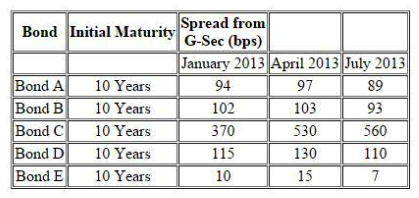 Further following information is available about a particular bond 'Bond F' There is a 10.25% risky bond with a maturity of 2.25% year(s) its current price is INR105.31, which corresponds to YTM of 9.22%. The following are the benchmark YTMs.
Further following information is available about a particular bond 'Bond F' There is a 10.25% risky bond with a maturity of 2.25% year(s) its current price is INR105.31, which corresponds to YTM of 9.22%. The following are the benchmark YTMs.  Compute interpolated spread for Bond F based on the information provided in the vignette:
Compute interpolated spread for Bond F based on the information provided in the vignette:
A) 1.64%
B) 0.43%
C) 0.61%
D) 1.46%
 Further following information is available about a particular bond 'Bond F' There is a 10.25% risky bond with a maturity of 2.25% year(s) its current price is INR105.31, which corresponds to YTM of 9.22%. The following are the benchmark YTMs.
Further following information is available about a particular bond 'Bond F' There is a 10.25% risky bond with a maturity of 2.25% year(s) its current price is INR105.31, which corresponds to YTM of 9.22%. The following are the benchmark YTMs.  Compute interpolated spread for Bond F based on the information provided in the vignette:
Compute interpolated spread for Bond F based on the information provided in the vignette:A) 1.64%
B) 0.43%
C) 0.61%
D) 1.46%

Unlock Deck
Unlock for access to all 83 flashcards in this deck.
Unlock Deck
k this deck
78
"Following four entities operate in the Indian IT and BPO space. They all are into same segment of providing off-shore analytical services. They all operate on the labour cost-arbitrage in India and the countries of their clients. Following information pertains for the year ended March 31, 201 3. 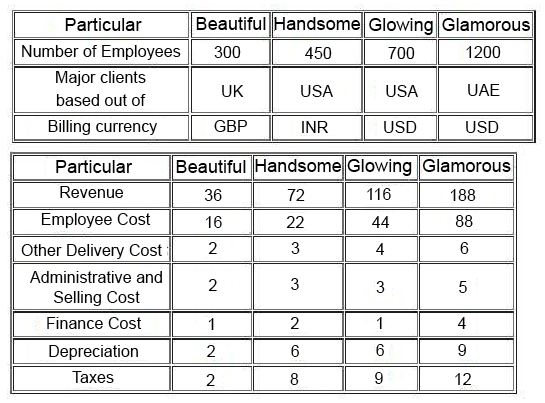
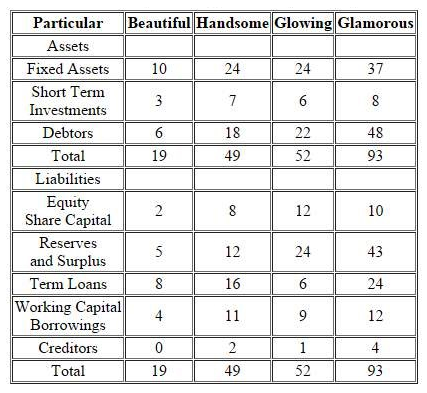 The year FY13, was typically a good year for Indian IT companies. For FY14, the economic analysts have given following predictions about the IT Industry: A) It is expected that INR will appreciate sharply against other USD. B) Given high inflation and attrition in IT Industry in India, the wages of IT sector employees will increase more sharply than Inflation and general wage rise in country. C) US Congress will be passing a bill which restricts the outsourcing to third world countries like India. While analyzing the four entities, you come across following findings related to Glowing: Glowing is promoted by Mr.M R Bhutta, who has earlier promoted two other business ventures, He started with ABC Entertainment Ltd in 1996 and was promoter and MD of the company. ABC was a listed entity and its share price had sharp movements at the time of stock market scam in late 1990s. In 1999, Mr.Bhutta sold his entire stake and resigned from the post of MD. The stock price declined by about 90% in coming days and has never recovered. Later on in 2003, Mr. Bhutta again promoted a new business, Klear Publications Ltd (KCL) an in the business of magazine publication. The entity had come out with a successful IPO and raised money from public. Thereafter it ran into troubles and reported losses. In 2009, Mr. Bhutta went on to exit this business as well by selling stake to other promoter(s). There have been reports in both instances with allegations that promoters have siphoned off money from listed entities to other group entities, however, nothing has been proved in any court." What will be impact of on the predictions A and B of the economic analysts, on companies:
The year FY13, was typically a good year for Indian IT companies. For FY14, the economic analysts have given following predictions about the IT Industry: A) It is expected that INR will appreciate sharply against other USD. B) Given high inflation and attrition in IT Industry in India, the wages of IT sector employees will increase more sharply than Inflation and general wage rise in country. C) US Congress will be passing a bill which restricts the outsourcing to third world countries like India. While analyzing the four entities, you come across following findings related to Glowing: Glowing is promoted by Mr.M R Bhutta, who has earlier promoted two other business ventures, He started with ABC Entertainment Ltd in 1996 and was promoter and MD of the company. ABC was a listed entity and its share price had sharp movements at the time of stock market scam in late 1990s. In 1999, Mr.Bhutta sold his entire stake and resigned from the post of MD. The stock price declined by about 90% in coming days and has never recovered. Later on in 2003, Mr. Bhutta again promoted a new business, Klear Publications Ltd (KCL) an in the business of magazine publication. The entity had come out with a successful IPO and raised money from public. Thereafter it ran into troubles and reported losses. In 2009, Mr. Bhutta went on to exit this business as well by selling stake to other promoter(s). There have been reports in both instances with allegations that promoters have siphoned off money from listed entities to other group entities, however, nothing has been proved in any court." What will be impact of on the predictions A and B of the economic analysts, on companies:
A) Handsome: No Impact on sales; Margins may squeeze; Glowing: INR Sales may decline; margins may squeeze.
B) Handsome: INRSales may increase; margins may squeeze; Glowing: INRSales will increase; margins may squeeze.
C) Handsome: INR Sales may decline; margins may squeeze; Glowing: INR Sales may decline; margins may squeeze.
D) Handsome: No Impact on sales; Margins may squeeze; Glowing: No Impact on sales; Margins may squeeze.

 The year FY13, was typically a good year for Indian IT companies. For FY14, the economic analysts have given following predictions about the IT Industry: A) It is expected that INR will appreciate sharply against other USD. B) Given high inflation and attrition in IT Industry in India, the wages of IT sector employees will increase more sharply than Inflation and general wage rise in country. C) US Congress will be passing a bill which restricts the outsourcing to third world countries like India. While analyzing the four entities, you come across following findings related to Glowing: Glowing is promoted by Mr.M R Bhutta, who has earlier promoted two other business ventures, He started with ABC Entertainment Ltd in 1996 and was promoter and MD of the company. ABC was a listed entity and its share price had sharp movements at the time of stock market scam in late 1990s. In 1999, Mr.Bhutta sold his entire stake and resigned from the post of MD. The stock price declined by about 90% in coming days and has never recovered. Later on in 2003, Mr. Bhutta again promoted a new business, Klear Publications Ltd (KCL) an in the business of magazine publication. The entity had come out with a successful IPO and raised money from public. Thereafter it ran into troubles and reported losses. In 2009, Mr. Bhutta went on to exit this business as well by selling stake to other promoter(s). There have been reports in both instances with allegations that promoters have siphoned off money from listed entities to other group entities, however, nothing has been proved in any court." What will be impact of on the predictions A and B of the economic analysts, on companies:
The year FY13, was typically a good year for Indian IT companies. For FY14, the economic analysts have given following predictions about the IT Industry: A) It is expected that INR will appreciate sharply against other USD. B) Given high inflation and attrition in IT Industry in India, the wages of IT sector employees will increase more sharply than Inflation and general wage rise in country. C) US Congress will be passing a bill which restricts the outsourcing to third world countries like India. While analyzing the four entities, you come across following findings related to Glowing: Glowing is promoted by Mr.M R Bhutta, who has earlier promoted two other business ventures, He started with ABC Entertainment Ltd in 1996 and was promoter and MD of the company. ABC was a listed entity and its share price had sharp movements at the time of stock market scam in late 1990s. In 1999, Mr.Bhutta sold his entire stake and resigned from the post of MD. The stock price declined by about 90% in coming days and has never recovered. Later on in 2003, Mr. Bhutta again promoted a new business, Klear Publications Ltd (KCL) an in the business of magazine publication. The entity had come out with a successful IPO and raised money from public. Thereafter it ran into troubles and reported losses. In 2009, Mr. Bhutta went on to exit this business as well by selling stake to other promoter(s). There have been reports in both instances with allegations that promoters have siphoned off money from listed entities to other group entities, however, nothing has been proved in any court." What will be impact of on the predictions A and B of the economic analysts, on companies:A) Handsome: No Impact on sales; Margins may squeeze; Glowing: INR Sales may decline; margins may squeeze.
B) Handsome: INRSales may increase; margins may squeeze; Glowing: INRSales will increase; margins may squeeze.
C) Handsome: INR Sales may decline; margins may squeeze; Glowing: INR Sales may decline; margins may squeeze.
D) Handsome: No Impact on sales; Margins may squeeze; Glowing: No Impact on sales; Margins may squeeze.

Unlock Deck
Unlock for access to all 83 flashcards in this deck.
Unlock Deck
k this deck
79
Case Facts as on March 31, 2012 Mark Construction Company (MCC) has bagged a contract for construction of a large dam and hydro power project on river Shivna in Madhya Pradesh (MP). The project is also of relevance from the irrigation perspective due to its location and as per the agreement MCC will have to undertake construction of web of canals, approach road to dam, power house and other ancillary units. MCC is promoted by Mr. Thomas Mark, who is a MP from the ruling party which recently formed government in MP. Historically, MCC has been engaged into construction of rural roads, small bridges and railway platforms on contract basis for the Government. MCC will have a separate special purpose vehicle (SPV) floated for this venture. The hydro power project comes under the public private partnership scheme of the Government of MP, where in the private partner builds owns operates and transfers (BOOT) the hydro power plant. The detailed terms of the hydro power project agreement are as follows:
1) The construction of the dam, canals and hydro power plant shall be undertaken by the contractor. The Government of MP will have to acquire land which will submerge on construction of dam and shall rehabilitate the owners of land.
2) MCC shall have right to operate the hydro power project from date of commencement of commercial operations (DCCO) for a period of 20 years and shall transfer the project to Government thereafter. Further, SPV shall be tax exempt for a period of five years from DCCO i.e. FY17-FY21.
3)The power project is of 600 megawatts (MW) shall comprise 4 units of 150 MW each. The estimated cost of project is about INR3, 500 Million to be spent over a period of 4 year(s) the project is estimated to be commercially operational by April 1, 2016 with two units operational om same day and one unit each will be operational on April 1, 2017 and April 1, 2018.
4)Means of finance: Means of Finance INR Million Government Aid (To be classified as Equity) 500Equity 900 Debt 2100
Means of Finance INR Million Government Aid (To be classified as Equity) 500Equity 900 Debt 2100
5)Amount if expenditure estimated in various years is as follows: Debt shall bear a fixed rate of interest of 10% and all interest till DCCO shall be added to the principal. The expected principal along with capitalized interest is expected to be INR2, 400 Million (i.e.INR2100 Million debt plus INR300 Million capitalized interest). The repayment of the same shall be in 12 equated annual installments starting from FY17. Brief projections for the period of FY17 to FY21 are given below: Developments as on March 31, 2015 The project manager for the SPV made following comments at a press conferee on March 31, 2015: As you all are aware, we were running bang on schedule till we last met on December 21, 2014.From today we are just left with one more year to complete the project in time. However, the flash floods which struck our dam site on this March 15, 2015 have created havoc in the region. I shall not point out the loss of lives in the region as you all are well aware of those. Our project has also been badly hit due to the same and we have been assessing the damage over the last one week. After analyzing damage, we have made changes in project schedule. Now we will be making only one unit of 150 MW operational on April 1, 2016 and 1 unit each will be added in each of subsequent year(s). Development as on September 30, 2015 Post the flash floods, lot of environmentalists started raising issues of changes in environment due to construction of large number of dams. A few Public Interest Litigations (PILs) have been filed in various courts. Honorable High Court of MP on September 27, 2015, banned construction of any dams in the region and banned permissions for new dams till next hearing scheduled on November 30, 201
Developments as on March 31, 2015 The project manager for the SPV made following comments at a press conferee on March 31, 2015: As you all are aware, we were running bang on schedule till we last met on December 21, 2014.From today we are just left with one more year to complete the project in time. However, the flash floods which struck our dam site on this March 15, 2015 have created havoc in the region. I shall not point out the loss of lives in the region as you all are well aware of those. Our project has also been badly hit due to the same and we have been assessing the damage over the last one week. After analyzing damage, we have made changes in project schedule. Now we will be making only one unit of 150 MW operational on April 1, 2016 and 1 unit each will be added in each of subsequent year(s). Development as on September 30, 2015 Post the flash floods, lot of environmentalists started raising issues of changes in environment due to construction of large number of dams. A few Public Interest Litigations (PILs) have been filed in various courts. Honorable High Court of MP on September 27, 2015, banned construction of any dams in the region and banned permissions for new dams till next hearing scheduled on November 30, 201
5)MCC in its press release has indicated that they will apply to the higher court on the matter. As a credit rating analyst on September 30, 2015, on receipt of the high court order, what rating action you will take:
A) Put ratings on rating watch.
B) Change rating outlook for long term to negative.
C) No action, wait for order if higher courts or hearing on November 30, 2015.
D) Immediately downgrade ratings of SPV.
1) The construction of the dam, canals and hydro power plant shall be undertaken by the contractor. The Government of MP will have to acquire land which will submerge on construction of dam and shall rehabilitate the owners of land.
2) MCC shall have right to operate the hydro power project from date of commencement of commercial operations (DCCO) for a period of 20 years and shall transfer the project to Government thereafter. Further, SPV shall be tax exempt for a period of five years from DCCO i.e. FY17-FY21.
3)The power project is of 600 megawatts (MW) shall comprise 4 units of 150 MW each. The estimated cost of project is about INR3, 500 Million to be spent over a period of 4 year(s) the project is estimated to be commercially operational by April 1, 2016 with two units operational om same day and one unit each will be operational on April 1, 2017 and April 1, 2018.
4)Means of finance:
 Means of Finance INR Million Government Aid (To be classified as Equity) 500Equity 900 Debt 2100
Means of Finance INR Million Government Aid (To be classified as Equity) 500Equity 900 Debt 21005)Amount if expenditure estimated in various years is as follows: Debt shall bear a fixed rate of interest of 10% and all interest till DCCO shall be added to the principal. The expected principal along with capitalized interest is expected to be INR2, 400 Million (i.e.INR2100 Million debt plus INR300 Million capitalized interest). The repayment of the same shall be in 12 equated annual installments starting from FY17. Brief projections for the period of FY17 to FY21 are given below:
 Developments as on March 31, 2015 The project manager for the SPV made following comments at a press conferee on March 31, 2015: As you all are aware, we were running bang on schedule till we last met on December 21, 2014.From today we are just left with one more year to complete the project in time. However, the flash floods which struck our dam site on this March 15, 2015 have created havoc in the region. I shall not point out the loss of lives in the region as you all are well aware of those. Our project has also been badly hit due to the same and we have been assessing the damage over the last one week. After analyzing damage, we have made changes in project schedule. Now we will be making only one unit of 150 MW operational on April 1, 2016 and 1 unit each will be added in each of subsequent year(s). Development as on September 30, 2015 Post the flash floods, lot of environmentalists started raising issues of changes in environment due to construction of large number of dams. A few Public Interest Litigations (PILs) have been filed in various courts. Honorable High Court of MP on September 27, 2015, banned construction of any dams in the region and banned permissions for new dams till next hearing scheduled on November 30, 201
Developments as on March 31, 2015 The project manager for the SPV made following comments at a press conferee on March 31, 2015: As you all are aware, we were running bang on schedule till we last met on December 21, 2014.From today we are just left with one more year to complete the project in time. However, the flash floods which struck our dam site on this March 15, 2015 have created havoc in the region. I shall not point out the loss of lives in the region as you all are well aware of those. Our project has also been badly hit due to the same and we have been assessing the damage over the last one week. After analyzing damage, we have made changes in project schedule. Now we will be making only one unit of 150 MW operational on April 1, 2016 and 1 unit each will be added in each of subsequent year(s). Development as on September 30, 2015 Post the flash floods, lot of environmentalists started raising issues of changes in environment due to construction of large number of dams. A few Public Interest Litigations (PILs) have been filed in various courts. Honorable High Court of MP on September 27, 2015, banned construction of any dams in the region and banned permissions for new dams till next hearing scheduled on November 30, 2015)MCC in its press release has indicated that they will apply to the higher court on the matter. As a credit rating analyst on September 30, 2015, on receipt of the high court order, what rating action you will take:
A) Put ratings on rating watch.
B) Change rating outlook for long term to negative.
C) No action, wait for order if higher courts or hearing on November 30, 2015.
D) Immediately downgrade ratings of SPV.

Unlock Deck
Unlock for access to all 83 flashcards in this deck.
Unlock Deck
k this deck
80
Following is information related banks: Auckland Ltd is a public sector bank operating with about 120 branches across India. The bank has been in business since 1971 and has about 40% branches in rural areas and about 75% of all branches are in Western India. On the basis of the size, Auckland Ltd will be ranked at number 31 amongst 40 banks in India. Although top management has appointment period of 5 years, generally they retire on ach sieving age of 60 years with an average tenure of only 2 years at the top job. Profit and Loss Account 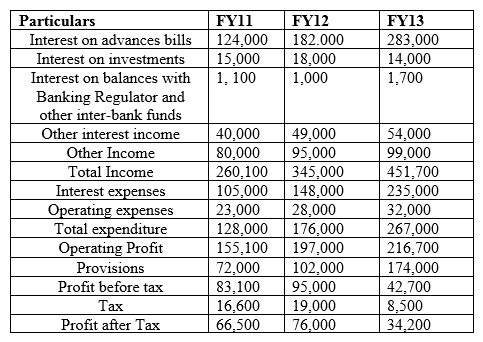 Balance Sheet
Balance Sheet 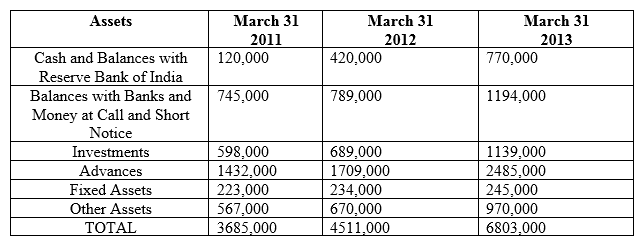
 The rating wise break-up of assets for FY11 is as follows:
The rating wise break-up of assets for FY11 is as follows:  The ROTA for Auckland deteriorated from ___in FY12 to___ in FY13.
The ROTA for Auckland deteriorated from ___in FY12 to___ in FY13.
A) 0,.7%, 0,3%
B) 7%; 2%
C) 2.3%; 0.7%
D) 1.9%; 0.6%
 Balance Sheet
Balance Sheet 
 The rating wise break-up of assets for FY11 is as follows:
The rating wise break-up of assets for FY11 is as follows:  The ROTA for Auckland deteriorated from ___in FY12 to___ in FY13.
The ROTA for Auckland deteriorated from ___in FY12 to___ in FY13.A) 0,.7%, 0,3%
B) 7%; 2%
C) 2.3%; 0.7%
D) 1.9%; 0.6%

Unlock Deck
Unlock for access to all 83 flashcards in this deck.
Unlock Deck
k this deck



